文献翻译 食品专业
英文文献翻译
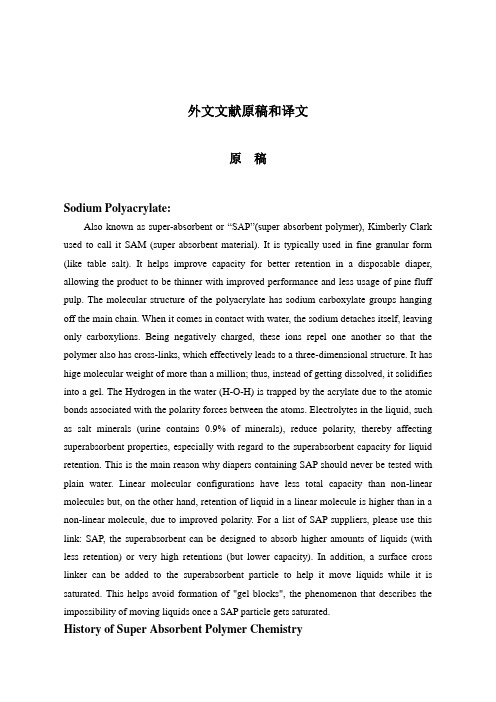
外文文献原稿和译文原稿Sodium Polyacrylate:Also known as super-absorbent or “SAP”(super absorbent polymer), Kimberly Clark used to call it SAM (super absorbent material). It is typically used in fine granular form (like table salt). It helps improve capacity for better retention in a disposable diaper, allowing the product to be thinner with improved performance and less usage of pine fluff pulp. The molecular structure of the polyacrylate has sodium carboxylate groups hanging off the main chain. When it comes in contact with water, the sodium detaches itself, leaving only carboxylions. Being negatively charged, these ions repel one another so that the polymer also has cross-links, which effectively leads to a three-dimensional structure. It has hige molecular weight of more than a million; thus, instead of getting dissolved, it solidifies into a gel. The Hydrogen in the water (H-O-H) is trapped by the acrylate due to the atomic bonds associated with the polarity forces between the atoms. Electrolytes in the liquid, such as salt minerals (urine contains 0.9% of minerals), reduce polarity, thereby affecting superabsorbent properties, especially with regard to the superabsorbent capacity for liquid retention. This is the main reason why diapers containing SAP should never be tested with plain water. Linear molecular configurations have less total capacity than non-linear molecules but, on the other hand, retention of liquid in a linear molecule is higher than in a non-linear molecule, due to improved polarity. For a list of SAP suppliers, please use this link: SAP, the superabsorbent can be designed to absorb higher amounts of liquids (with less retention) or very high retentions (but lower capacity). In addition, a surface cross linker can be added to the superabsorbent particle to help it move liquids while it is saturated. This helps avoid formation of "gel blocks", the phenomenon that describes the impossibility of moving liquids once a SAP particle gets saturated.History of Super Absorbent Polymer ChemistryUn til the 1980’s, water absorbing materials were cellulosic or fiber-based products. Choices were tissue paper, cotton, sponge, and fluff pulp. The water retention capacity of these types of materials is only 20 times their weight – at most.In the early 1960s, the United States Department of Agriculture (USDA) was conducting work on materials to improve water conservation in soils. They developed a resin based on the grafting of acrylonitrile polymer onto the backbone of starch molecules (i.e. starch-grafting). The hydrolyzed product of the hydrolysis of this starch-acrylonitrile co-polymer gave water absorption greater than 400 times its weight. Also, the gel did not release liquid water the way that fiber-based absorbents do.The polymer came to be known as “Super Slurper”.The USDA gave the technical know how several USA companies for further development of the basic technology. A wide range of grating combinations were attempted including work with acrylic acid, acrylamide and polyvinyl alcohol (PVA).Since Japanese companies were excluded by the USDA, they started independent research using starch, carboxy methyl cellulose (CMC), acrylic acid, polyvinyl alcohol (PVA) and isobutylene maleic anhydride (IMA).Early global participants in the development of super absorbent chemistry included Dow Chemical, Hercules, General Mills Chemical, DuPont, National Starch & Chemical, Enka (Akzo), Sanyo Chemical, Sumitomo Chemical, Kao, Nihon Starch and Japan Exlan.In the early 1970s, super absorbent polymer was used commercially for the first time –not for soil amendment applications as originally intended –but for disposable hygienic products. The first product markets were feminine sanitary napkins and adult incontinence products.In 1978, Park Davis (d.b.a. Professional Medical Products) used super absorbent polymers in sanitary napkins.Super absorbent polymer was first used in Europe in a baby diaper in 1982 when Schickendanz and Beghin-Say added the material to the absorbent core. Shortly thereafter, UniCharm introduced super absorbent baby diapers in Japan while Proctor & Gamble and Kimberly-Clark in the USA began to use the material.The development of super absorbent technology and performance has been largely led by demands in the disposable hygiene segment. Strides in absorption performance have allowed the development of the ultra-thin baby diaper which uses a fraction of the materials – particularly fluff pulp – which earlier disposable diapers consumed.Over the years, technology has progressed so that there is little if any starch-grafted super absorbent polymer used in disposable hygienic products. These super absorbents typically are cross-linked acrylic homo-polymers (usually Sodium neutralized).Super absorbents used in soil amendments applications tend to be cross-linked acrylic-acrylamide co-polymers (usually Potassium neutralized).Besides granular super absorbent polymers, ARCO Chemical developed a super absorbent fiber technology in the early 1990s. This technology was eventually sold to Camelot Absorbents. There are super absorbent fibers commercially available today. While significantly more expensive than the granular polymers, the super absorbent fibers offer technical advantages in certain niche markets including cable wrap, medical devices and food packaging.Sodium polyacrylate, also known as waterlock, is a polymer with the chemical formula [-CH2-CH(COONa)-]n widely used in consumer products. It has the ability to absorb as much as 200 to 300 times its mass in water. Acrylate polymers generally are considered to possess an anionic charge. While sodium neutralized polyacrylates are the most common form used in industry, there are also other salts available including potassium, lithium and ammonium.ApplicationsAcrylates and acrylic chemistry have a wide variety of industrial uses that include: ∙Sequestering agents in detergents. (By binding hard water elements such as calcium and magnesium, the surfactants in detergents work more efficiently.) ∙Thickening agents∙Coatings∙Fake snowSuper absorbent polymers. These cross-linked acrylic polymers are referred to as "Super Absorbents" and "Water Crystals", and are used in baby diapers. Copolymerversions are used in agriculture and other specialty absorbent applications. The origins of super absorbent polymer chemistry trace back to the early 1960s when the U.S. Department of Agriculture developed the first super absorbent polymer materials. This chemical is featured in the Maximum Absorbency Garment used by NASA.译文聚丙烯酸钠聚丙烯酸钠,又可以称为超级吸收剂或者又叫高吸水性树脂,凯博利克拉克教授曾经称它为SAM即:超级吸收性物质。
各专业英文翻译
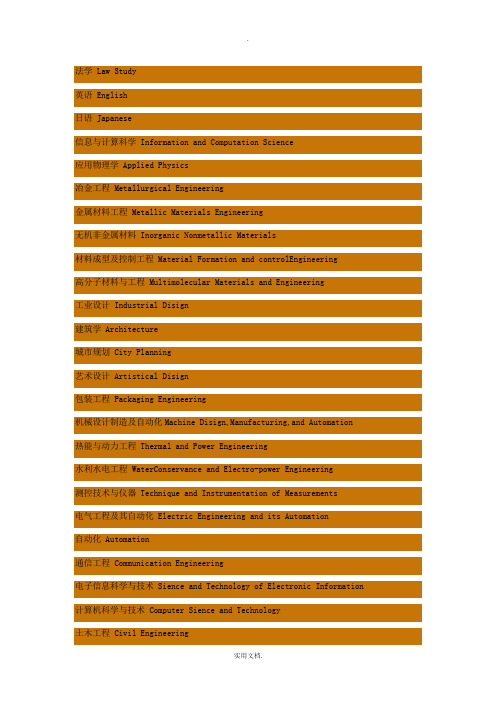
法学 Law Study英语 English日语 Japanese信息与计算科学 Information and Computation Science应用物理学 Applied Physics冶金工程 Metallurgical Engineering金属材料工程 Metallic Materials Engineering无机非金属材料 Inorganic Nonmetallic Materials材料成型及控制工程 Material Formation and controlEngineering高分子材料与工程 Multimolecular Materials and Engineering工业设计 Industrial Disign建筑学 Architecture城市规划 City Planning艺术设计 Artistical Disign包装工程 Packaging Engineering机械设计制造及自动化Machine Disign,Manufacturing,and Automation热能与动力工程 Thermal and Power Engineering水利水电工程 WaterConservance and Electro-power Engineering测控技术与仪器 Technique and Instrumentation of Measurements电气工程及其自动化 Electric Engineering and its Automation自动化 Automation通信工程 Communication Engineering电子信息科学与技术 Sience and Technology of Electronic Information 计算机科学与技术 Computer Sience and Technology土木工程 Civil Engineering工程管理 Project Management给水排水工程 Water Supply and Sewage Engineering建筑环境与设备工程 Constructional Environment and Equipment Engineering 过程装备与控制工程 Processing Units and Control Engineering环境工程 Environmental Engineering化学工程与工艺 Chemacal Engineering and Technology平安工程 Safty Engineering工商管理 Industrial and Commercial Management市场营销 Market Management and Sales会计学 Accounting旅游管理 Tourism Management信息管理与信息系统 Information Management and System金融学 Finance国际经济与贸易 International Economy and Trade食品科学与工程 Food Sience and Engineering生物工程 Biological Engineering纺织工程 Textile Engineering建筑环境与设备工程、Constructional Environment and Equipment Engineering 过程装备与控制工程、Processing Units and Control Engineering现代家政学、 Modern Domestic Science运动训练科学系、 Sports Train Science食品营养与检测、 Food Nutrition and Detect国际新闻、 International News体育健康教育系 Sports Health Education哲学 Philosophy马克思主义哲学 Philosophy of Marxism中国哲学 Chinese Philosophy外国哲学 Foreign Philosophies逻辑学 Logic伦理学 Ethics美学 Aesthetics宗教学 Science of Religion科学技术哲学 Philosophy of Science and Technology经济学 Economics理论经济学 Theoretical Economics政治经济学 Political Economy经济思想史 History of Economic Thought经济史 History of Economic西方经济学 Western Economics世界经济 World Economics人口、资源与环境经济学 Population, Resources and Environmental Economics应用经济学 Applied Economics国民经济学 National Economics区域经济学 Regional Economics财政学〔含税收学〕 Public Finance (including Taxation)金融学〔含保险学〕 Finance (including Insurance)产业经济学 Industrial Economics国际贸易学 International Trade劳动经济学 Labor Economics统计学 Statistics数量经济学 Quantitative Economics中文学科、专业名称英文学科、专业名称国防经济学 National Defense Economics法学 Law法学 Science of Law法学理论 Jurisprudence法律史 Legal History宪法学与行政法学 Constitutional Law and Administrative Law 刑法学 Criminal Jurisprudence民商法学(含劳动法学、社会保障法学) Civil Law and Commercial Law (including Science of Labour Law and Science of Social Security Law )诉讼法学 Science of Procedure Laws经济法学 Science of Economic Law环境与资源保护法学 Science of Environment and Natural Resources Protection Law国际法学(含国际公法学、国际私法学、国际经济法学、) International law (including International Public law, International Private Law and International Economic Law)军事法学 Science of Military Law政治学 Political Science政治学理论 Political Theory中外政治制度 Chinese and Foreign Political Institution科学社会主义与国际共产主义运动 Scientific Socialism and InternationalCommunist Movement中*史(含党的学说与党的建设) History of the Communist Party of China(including the Doctrine of China Party and Party Building) 马克思主义理论与思想政治教育 Education of Marxist Theory and Education in Ideology and Politics国际政治学 International Politics国际关系学 International Relations外交学 Diplomacy社会学 Sociology社会学 Sociology人口学 Demography人类学 Anthropology民俗学(含中国民间文学) Folklore (including Chinese Folk Literature)民族学 Ethnology民族学 Ethnology马克思主义民族理论与政策 Marxist Ethnic Theory and Policy 中国少数民族经济 Chinese Ethnic Economics中国少数民族史 Chinese Ethnic History中国少数民族艺术 Chinese Ethnic Art教育学 Education教育学 Education Science教育学原理 Educational Principle课程与教学论 Curriculum and Teaching Methodology教育史 History of Education比拟教育学 Comparative Education学前教育学 Pre-school Education高等教育学 Higher Education成人教育学 Adult Education职业技术教育学 Vocational and Technical Education特殊教育学 Special Education教育技术学 Education Technology心理学 Psychology根底心理学 Basic Psychology开展与心理学 Developmental and Educational Psychology应用心理学 Applied Psychology体育学 Science of Physical Culture and Sports体育人文社会学 Humane and Sociological Science of Sports 运动人体科学 Human Movement Science体育教育训练学 Theory of Sports Pedagogy and Training民族传统体育学 Science of Ethnic Traditional Sports文学 Literature中国语言文学 Chinese Literature文艺学 Theory of Literature and Art语言学及应用语言学 Linguistics and Applied Linguistics汉语言文字学 Chinese Philology中国古典文献学 Study of Chinese Classical Text中国古代文学 Ancient Chinese Literature中国现当代文学 Modern and Contemporary Chinese Literature 中国少数民族语言文学 Chinese Ethnic Language and Literature比拟文学与世界文学 Comparative Literature and World Literature外国语言文学 Foreign Languages and Literatures英语语言文学 English Language and Literature俄语语言文学 Russian Language and Literature法语语言文学 French Language and Literature德语语言文学 German Language and Literature日语语言文学 Japanese Language and Literature印度语言文学 Indian Language and Literature西班牙语语言文学 Spanish Language and Literature阿拉伯语语言文学 Arabic Language and Literature欧洲语言文学 European Language and Literature亚非语言文学 Asian-African Language and Literature外国语言学及应用语言学 Linguistics and Applied Linguistics in Foreign Languages新闻传播学 Journalism and Communication新闻学 Journalism传播学 Communication艺术学 Art艺术学 Art Theory音乐学 Music美术学 Fine Arts设计艺术学 Artistic Design戏剧戏曲学 Theater and Chinese Traditional Opera电影学 Film播送电视艺术学 Radio and television Art舞蹈学 Dance历史学 History历史学 History史学理论及史学史 Historical Theories and History of Historical Science考古学及博物馆学 Archaeology and Museology历史地理学 Historical Geography历史文献学(含敦煌学、古文字学) Studies of Historical Literature (includingPaleography and Studies of Dunhuang)专门史 History of Particular Subjects中国古代史 Ancient Chinese History中国近现代史 Modern and Contemporary Chinese History世界史 World History理学 Natural Science数学 Mathematics根底数学 Fundamental Mathematics计算数学 Computational Mathematics概率论与数理统计 Probability and Mathematical Statistics 应用数学 Applied mathematics运筹学与控制论 Operational Research and Cybernetics物理学 Physics理论物理 Theoretical Physics粒子物理与原子核物理 Particle Physics and Nuclear Physics原子与分子物理 Atomic and Molecular Physics等离子体物理 Plasma Physics凝聚态物理 Condensed Matter Physics声学 Acoustics光学 Optics无线电物理 Radio Physics化学 Chemistry无机化学 Inorganic Chemistry分析化学 Analytical Chemistry有机化学 Organic Chemistry物理化学〔含化学物理〕 Physical Chemistry (including Chemical Physics)高分子化学与物理 Chemistry and Physics of Polymers天文学 Astronomy天体物理 Astrophysics天体测量与天体力学 Astrometry and Celestial Mechanics地理学 Geography自然地理学 Physical Geography人文地理学 Human Geography地图学与地理信息系统 Cartography and Geography Information System大气科学 Atmospheric Sciences气象学 Meteorology大气物理学与大气环境 Atmospheric Physics and Atmospheric Environment海洋科学 Marine Sciences物理海洋学 Physical Oceanography海洋化学 Marine Chemistry海洋生理学 Marine Biology海洋地质学 Marine Geology地球物理学 Geophysics固体地球物理学 Solid Earth Physics空间物理学 Space Physics地质学 Geology矿物学、岩石学、矿床学 Mineralogy, Petrology, Mineral Deposit Geology地球化学 Geochemistry古生物学与地层学〔含古人类学〕 Paleontology and Stratigraphy (including Paleoanthropology)构造地质学 Structural Geology第四纪地质学 Quaternary Geology生物学 Biology植物学 Botany动物学 Zoology生理学 Physiology水生生物学 Hydrobiology微生物学 Microbiology神经生物学 Neurobiology遗传学 Genetics发育生物学 Developmental Biology细胞生物学 Cell Biology生物化学与分子生物学 Biochemistry and Molecular Biology 生物物理学 Biophysics生态学 Ecology系统科学 Systems Science系统理论 Systems Theory系统分析与集成 Systems Analysis and Integration科学技术史 History of Science and Technology工学 Engineering力学 Mechanics一般力学与力学根底 General and Fundamental Mechanics固体力学 Solid Mechanics流体力学 Fluid Mechanics工程力学 Engineering Mechanics机械工程 Mechanical Engineering机械制造及其自动化 Mechanical Manufacture and Automation 机械电子工程 Mechatronic Engineering机械设计与理论 Mechanical Design and Theory车辆工程 Vehicle Engineering光学工程 Optical Engineering仪器科学与技术 Instrument Science and Technology精密仪器及机械 Precision Instrument and Machinery测试计量技术及仪器 Measuring and Testing Technologies and Instruments材料科学与工程 Materials Science and Engineering材料物理与化学 Materials Physics and Chemistry材料学 Materialogy材料加工工程 Materials Processing Engineering冶金工程 Metallurgical Engineering冶金物理化学 Physical Chemistry of Metallurgy钢铁冶金 Ferrous Metallurgy有色金属冶金 Non-ferrous Metallurgy动力工程及工程热物理 Power Engineering and Engineering Thermophysics工程热物理 Engineering Thermophysics热能工程 Thermal Power Engineering动力机械及工程 Power Machinery and Engineering流体机械及工程 Fluid Machinery and Engineering制冷及低温工程 Refrigeration and Cryogenic Engineering化工过程机械 Chemical Process Equipment电气工程 Electrical Engineering电机与电器 Electric Machines and Electric Apparatus电力系统及其自动化 Power System and its Automation高电压与绝缘技术 High Voltage and Insulation Technology 电力电子与电力传动 Power Electronics and Power Drives电工理论与新技术 Theory and New Technology of Electrical Engineering电子科学与技术 Electronics Science and Technology物理电子学 Physical Electronics电路与系统 Circuits and Systems微电子学与固体电子学 Microelectronics and Solid State Electronics电磁场与微波技术 Electromagnetic Field and Microwave Technology信息与通信工程 Information and Communication Engineering 通信与信息系统 Communication and Information Systems信号与信息处理 Signal and Information Processing控制科学与工程 Control Science and Engineering控制理论与控制工程 Control Theory and Control Engineering检测技术与自动化装置 Detection Technology and Automatic Equipment系统工程 Systems Engineering模式识别与智能系统 Pattern Recognition and Intelligent Systems导航、制导与控制 Navigation, Guidance and Control计算机科学与技术 Computer Science and Technology计算机软件与理论 Computer Software and Theory计算机系统结构 Computer Systems Organization计算机应用技术 Computer Applied Technology建筑学 Architecture建筑历史与理论 Architectural History and Theory建筑设计及其理论 Architectural Design and Theory城市规划与设计〔含风景园林规划与设计〕 Urban Planning and Design (including Landscape Planning and Design)建筑技术科学 Building Technology Science土木工程 Civil Engineering岩土工程 Geotechnical Engineering结构工程 Structural Engineering市政工程 Municipal Engineering供热、供燃气、通风及空调工程 Heating, Gas Supply, Ventilating and Air Conditioning Engineering防灾减灾工程及防护工程 Disaster Prevention and Reduction Engineering and Protective Engineering桥梁与隧道工程 Bridge and Tunnel Engineering水利工程 Hydraulic Engineering水文学及水资源 Hydrology and Water Resources水力学及河流动力学 Hydraulics and River Dynamics水工结构工程 Hydraulic Structure Engineering水利水电工程 Hydraulic and Hydro-Power Engineering港口、海岸及近海工程 Harbor, Coastal and Offshore Engineering 测绘科学与技术 Surveying and Mapping大地测量学与测量工程 Geodesy and Survey Engineering摄影测量与遥感 Photogrammetry and Remote Sensing地图制图学与地理信息工程 Cartography and Geographic Information Engineering化学工程与技术 Chemical Engineering and Technology化学工程 Chemical Engineering化学工艺 Chemical Technology生物化工 Biochemical Engineering应用化学 Applied Chemistry工业催化 Industrial Catalysis地质资源与地质工程 Geological Resources and Geological Engineering矿产普查与勘探 Mineral Resource Prospecting and Exploration 地球探测与信息技术 Geodetection and Information Technology 地质工程 Geological Engineering矿业工程 Mineral Engineering采矿工程 Mining Engineering矿物加工工程 Mineral Processing Engineering平安技术及工程 Safety Technology and Engineering石油与天然气工程 Oil and Natural Gas Engineering油气井工程 Oil-Gas Well Engineering油气田开发工程 Oil-Gas Field Development Engineering油气储运工程 Oil-Gas Storage and Transportation Engineering 纺织科学与工程 Textile Science and Engineering纺织工程 Textile Engineering纺织材料与纺织品设计 Textile Material and Textiles Design纺织化学与染整工程 Textile Chemistry and Dyeing and Finishing Engineering服装设计与工程 Clothing Design and Engineering轻工技术与工程 The Light Industry Technology and Engineering 制浆造纸工程 Pulp and Paper Engineering制糖工程 Sugar Engineering发酵工程 Fermentation Engineering皮革化学与工程 Leather Chemistry and Engineering交通运输工程 Communication and Transportation Engineering道路与铁道工程 Highway and Railway Engineering交通信息工程及控制 Traffic Information Engineering & Control 交通运输规划与管理 Transportation Planning and Management载运工具运用工程 Vehicle Operation Engineering船舶与海洋工程 Naval Architecture and Ocean Engineering船舶与海洋结构物设计制造 Design and Construction of Naval Architecture and Ocean Structure轮机工程 Marine Engine Engineering水声工程 Underwater Acoustics Engineering航空宇航科学与技术 Aeronautical and Astronautical Science and Technology飞行器设计 Flight Vehicle Design航空宇航推进理论与工程 Aerospace Propulsion Theory and Engineering航空宇航器制造工程 Manufacturing Engineering of Aerospace Vehicle人机与环境工程 Man-Machine and Environmental Engineering兵器科学与技术 Armament Science and Technology武器系统与运用工程 Weapon Systems and Utilization Engineering 兵器发射理论与技术 Armament Launch Theory and Technology火炮、自动武器与弹药工程 Artillery, Automatic Gun and Ammunition Engineering军事化学与烟火技术 Military Chemistry and Pyrotechnics核科学与技术 Nuclear Science and Technology核能科学与工程 Nuclear Energy Science and Engineering核燃料循环与材料 Nuclear Fuel Cycle and Materials核技术及应用 Nuclear Technology and Applications辐射防护及环境保护 Radiation and Environmental Protection农业工程 Agricultural Engineering农业机械化工程 Agricultural Mechanization Engineering农业水土工程 Agricultural Water-Soil Engineering农业生物环境与能源工程 Agricultural Biological Environmental and Energy Engineering农业电气化与自动化 Agricultural Electrification and Automation林业工程 Forestry Engineering森林工程 Forest Engineering木材科学与技术 Wood Science and Technology林产化学加工工程 Chemical Processing Engineering of Forest Products环境科学与工程 Environmental Science and Engineering环境科学 Environmental Science环境工程 Environmental Engineering生物医学工程 Biomedical Engineering食品科学与工程 Food Science and Engineering食品科学 Food Science粮食、油脂及植物蛋白工程 Cereals, Oils and Vegetable Protein Engineering农产品加工及贮藏工程 Processing and Storage of Agriculture Products水产品加工及贮藏工程 Processing and Storage of Aquatic Products农学 Agriculture作物学 Crop Science作物栽培学与耕作学 Crop Cultivation and Farming System作物遗传育种学 Crop Genetics and Breeding园艺学 Horticulture果树学 Pomology蔬菜学 Olericulture茶学 Tea Science农业资源利用学 Utilization Science of Agricultural Resources 土壤学 Soil Science植物营养学 Plant Nutrition植物保护学 Plant Protection植物病理学 Plant Pathology农业昆虫与害虫防治 Agricultural Entomology and Pest Control 农药学 Pesticide Science畜牧学 Animal Science动物遗传育种与繁殖 Animal Genetics, Breeding and Reproduction Science动物营养与饲料科学 Animal Nutrition and Feed Science草业科学 Practaculture Science特种经济动物饲养学〔含蚕、蜂等〕 The Rearing of Special-type EconomicAnimals (including Silkworm, Honeybees, etc.)兽医学 Veterinary Medicine根底兽医学 Basic Veterinary Medicine预防兽医学 Preventive Veterinary Medicine临床兽医学 Clinical Veterinary Medicine林学 Forestry林木遗传育种学 Forest Tree Genetics and Breeding森林培育学 Silviculture森林保护学 Forest Protection森林经理学 Forest Management野生动植物保护与利用 Wildlife Conservation and Utilization 园林植物与欣赏园艺 Ornamental Plants and Horticulture水土保持与荒漠化防治 Soil and Water Conservation and Desertification Combating水产学 Fisheries Science水产养殖学 Aquaculture Science捕捞学 Fishing Science渔业资源学 Science of Fisheries Resources医学 Medicine根底医学 Basic Medicine人体解剖与组织胚胎学 Human Anatomy, Histology and Embryology 免疫学 Immunology病原生物学 Pathogenic Organisms病理学与病理生理学 Pathology and Pathophysiology法医学 Forensic Medicine放射医学 Radiation Medicine航空航天与航海医学 Aerospace and Nautical medicine临床医学 Clinical Medicine内科学〔含心血管病学、血液病学、呼吸系病学、消化系病学、内分泌与代谢病学、肾脏病学、风湿病学、传染病学〕 Internal medicine (including Cardiology, Hematology, Respiratory, Gastroenterology, Endocrinology and Metabolism, Nephrology, Rheuma-tology, Infectious Diseases)儿科学 Pediatrics老年医学 Geriatrics神经病学 Neurology精神病与精神卫生学 Psychiatry and Mental Health皮肤病与性病学 Dermatology and Venereology影像医学与核医学 Imaging and Nuclear Medicine临床检验诊断学 Clinical Laboratory Diagnostics护理学 Nursing外科学〔含普通外科学、骨外科学、泌尿外科学、胸心血管外科学、神经外科学、整形外科学、烧伤外科学、野战外科学〕 Surgery (General Surgery, Orthopedics, Urology, Cardiothoracic Surgery, Neurosurgery, Plastic Surgery, Burn Surgery, Field Surgery)妇产科学 Obstetrics and Gynecology眼科学 Ophthalmic Specialty耳鼻咽喉科学 Otolaryngology肿瘤学 Oncology康复医学与理疗学 Rehabilitation Medicine & Physical Therapy 运动医学 Sports Medicine麻醉学 Anesthesiology急诊医学 Emergency Medicine口腔医学 Stomatology口腔根底医学 Basic Science of Stomatology口腔临床医学 Clinical Science of Stomatology公共卫生与预防医学 Public Health and Preventive Medicine 流行病与卫生统计学 Epidemiology and Health Statistics劳动卫生与环境卫生学 Occupational and Environmental Health 营养与食品卫生学 Nutrition and Food Hygiene儿少卫生与妇幼保健学 Maternal, Child and Adolescent Health 卫生毒理学 Hygiene Toxicology军事预防医学 Military Preventive Medicine中医学 Chinese Medicine中医根底理论 Basic Theories of Chinese Medicine中医临床根底 Clinical Foundation of Chinese Medicine中医医史文献 History and Literature of Chinese Medicine方剂学 Formulas of Chinese Medicine中医诊断学 Diagnostics of Chinese Medicine中医内科学 Chinese Internal Medicine中医外科学 Surgery of Chinese Medicine中医骨伤科学 Orthopedics of Chinese Medicine中医妇科学 Gynecology of Chinese Medicine中医儿科学 Pediatrics of Chinese Medicine中医五官科学 Ophthalmology and Otolaryngoloy of Chinese Medicine针灸推拿学 Acupuncture and Moxibustion and Tuina of Chinese medicine民族医学 Ethnomedicine中西医结合医学 Chinese and Western Integrative Medicine中西医结合根底医学 Basic Discipline of Chinese and Western Integrative中西医结合临床医学 Clinical Discipline of Chinese and Western Integrative Medicine药学 Pharmaceutical Science药物化学 Medicinal Chemistry药剂学 Pharmaceutics生药学 Pharmacognosy药物分析学 Pharmaceutical Analysis微生物与生化药学 Microbial and Biochemical Pharmacy药理学 Pharmacology中药学 Science of Chinese Pharmacology军事学 Military Science军事思想学及军事历史学 Military Thought and Military History 军事思想学 Military Thought军事历史学 Military History战略学 Science of Strategy军事战略学 Military Strategy战争发动学 War Mobilization战役学 Science of Operations联合战役学 Joint Operation军种战役学〔含第二炮兵战役学〕 Armed Service Operation (including Operation of Strategic Missile Force)战术学 Science of Tactics合同战术学 Combined-Arms Tactics兵种战术学 Branch Tactics军队指挥学 Science of Command作战指挥学 Combat Command军事运筹学 Military Operation Research军事通信学 Military Communication军事情报学 Military Intelligence密码学 Cryptography军事教育训练学〔含军事体育学〕 Military Education and Training (including Military Physical Training)军制学 Science of Military System军事组织编制学 Military Organizational System军队管理学 Military Management军队政治工作学 Science of Military Political Work军事后勤学与军事装备学 Science of Military Logistics and Military Equipment军事后勤学 Military Logistics前方专业勤务 Rear Special Service军事装备学 Military Equipment管理学 Management Science管理科学与工程 Management Science and Engineering工商管理学 Science of Business Administration会计学 Accounting企业管理学〔含财务管理、市场营销学、人力资源管理学〕 Corporate Management (including Financial Management, Marketing, and Human Resources Management)旅游管理学 Tourist Management技术经济及管理学 Technology Economy and Management农林经济管理学 Agricultural and Forestry Economics & Management农业经济管理学 Agricultural Economics & Management林业经济管理学 Forestry Economics & Management公共管理学 Science of Public Management行政管理学 Administration Management社会医学与卫生事业管理学 Social Medicine and Health Management教育经济与管理学 Educational Economy and Management社会保障学 Social Security土地资源管理学 Land Resource Management图书馆、情报与档案学 Science of Library, Information and Archival图书馆学 Library Science情报学 Information Science档案学 Archival Science。
食品物流工程类外文文献翻译、中英文翻译
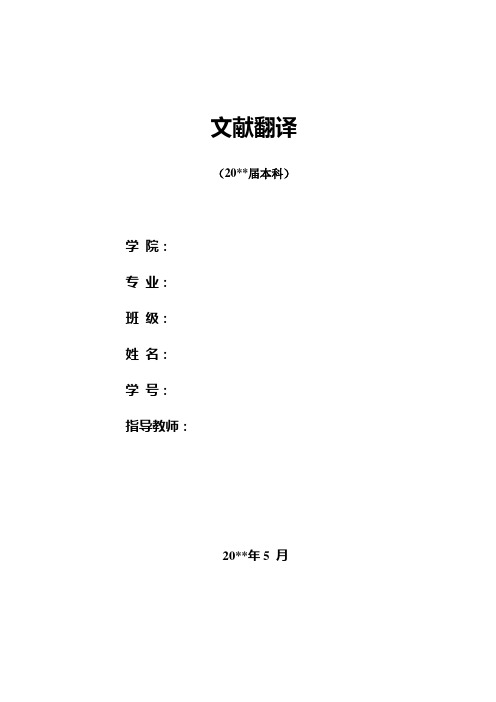
文献翻译(20**届本科)学院:专业:班级:姓名:学号:指导教师:20**年5 月Emerging technologies for keeping microbial and sensory quality of minimally fresh processed fruits and vegetablesThe emphasis in post-harvest fruit protection against quality attributes losses, physiological disorders, diseases and insects has shifted from using agro-chemicals to various alternative techniques, including biological control, cultural adaptations and physical methods such as controlled atmosphere (CA), MAP and irradiation. Given the restrictions of chemical use in plant foods and because many of them cause ecological problems or are potentially harmful to humans and may be withdrawn from use, the advantage of these alternative techniques is that no chemicals are involved (Artés, 1995; Graham and Stevenson, 1997; Reddy et al., 1998; Mathre et al., 1999; Sanz et al., 1999; Daugaard, 2000; Harker et al., 2000; Marquenie et al., 2003). Additionally, preservation techniques are becoming milder in response to demands of consumers for higher quality, more convenient foods that are less heavily processed and preserved and less reliant on chemical preservatives (Abee and Wounters, 1999).The unique way to assure microbial and sensory quality of minimally fresh processed plant products relies on refrigerated storage and distribution, although combination of refrigeration and subinhibitory preservation techniques could prolong their shelf-life.As mentioned above, many non-conventional methods are now being investigated; however, there are some limitations to their application since some methods are not applicable to fresh-cut fruits and vegetables because of damage to plant tissue but only to liquid foods such as fruit juices (Carlin and Nguyen-the, 1997). Therefore, in this section those techniques that can be used to preserve fresh processed plant foods will be revised.The most critical step in the production chain of minimal fresh processing of fruits and vegetables is washing-disinfection. For this reason, special attention to the alternative sanitizing agents as well as the new technologies for disinfection of these commodities will be given. To develop or improve washing and sanitizing treatments, special attention should be paid to the compatibility of treatments with commercial practices, cost, absence of induced adverse effects on product quality and the need for regulatory approval and consumer acceptance (Sapers, 2001). Some alternatives to sanitizing agents are: O3, ClO2, peracetic acid (about 90–100 ppm), H2O2, organic acids (acetic, lactic, citric, malic, sorbic and propionic acids at 300–500 mg/ml), electrolysed water, radio frequency, hot water treatments and UV-C radiation (Adams et al., 1989;Masson, 1990; Castañer et al., 1996; Tomás-Barberán et al., 1997; Delaquis et al., 1999, 2000, 2004; Sapers, 2001; Suslow, 2002; Jacxsens, 2002; Aguayo, 2003; Allende, 2003).1. Hydrogen peroxideTreatments of hydrogen peroxide (H2O2) seem to be a promising alternative to chlorine for disinfecting minimally fresh processed vegetables (Soliva-Fortuny and Martín-Belloso, 2003). H2O2 is generally recognized as safe (GRAS) for some food applications, but has not yet been approved as an antimicrobial wash. It does not produce residues since it is rapidly decomposed by the enzyme catalase to water and O2 (Sapers, 2001). Various experimental antimicrobial applications of H2O2 for foods have been described, including preservation of vegetable salads, berries and fresh-cut melons (Hagenmaier and Baker, 1997) since it reduces microbial populations and extends the shelf-life without causing loss of quality. Sapers and Simmons (1998) recommended its use for fresh-cut melon as it extended the shelf-life for 4–5 days in comparison to chlorine treatments. However, they demonstrated that H2O2 is injurious to some commodities, causing bleaching of anthocyanins in mechanically damaged berries. H2O2 vapour delayed or reduced the severity of bacterial soft rot in fresh processed cucumber, green bell pepper and zucchini, but no effect on spoilage of fresh-cut broccoli was found (Hagenmaier and Baker, 1997). Additionally, an extended shelf-life was found in fresh processed cucumbers, green bell peppers and zucchini after washing in a 5–10 per cent solution of H2O2 for 2 min (Sapers and Simmons, 1998). It means that the applicability of H2O2 to a broad range of minimally fresh processed vegetables should be determined, especially with commodities that are subject to rapid spoilage.2. Acidic electrolysed waterThis is a new disinfectant technique for fresh produce that has been shown to be efficient due to its antimicrobial and antiviral activities for fruit and vegetables (Izumi, 1999; Koseki and Itoh, 2000). Electrolysis of water containing a small amount of sodium chloride generates a highly acidic hypochlorous acid solution containing 10–100 ppm of available chlorine. Koseki et al. (2001) found that acidic electrolysed water (pH 2.6, oxidation reduction potential, 1140mV; 30 ppm of available chlorine) reduced viable aerobes in shredded lettuce by 2 log cfu/g within 10 min, showing a higher disinfectant effect than ozonated water. They reported that the use of this new technique could be applicable for food factory hygiene, meaning that the use of acidic electrolysed water at home or restaurant kitchen just before eating fresh fruits and vegetables could preventpoisoning.According to this, Park et al. (2002) reported population reductions on lettuce leaves exceeding2.49 log units for E. coli O157:H7 and L. monocytogenes and Horton et al. (1998) reported population reductions of E. coli O157:H7 on apples of3.7–4.6 log units cfu/g. However, Izumi (1999) only found 1 log unit cfu/g reduction in the microbial population of fresh-cut vegetables.3. Chlorine dioxideChlorine dioxide (ClO2) is a strong oxidizing agent (about 2.5 times the oxidative capacity of chlorine) having a broad biocide efficacy (Singh et al., 2002), including a good biofilm penetration. To date, the FDA (USFDA, 1998) has allowed the use of aqueous ClO2 in washing of uncut and unpeeled fruit and vegetables. However, ClO2 is unstable and it must be generated on-site and can be explosive when concentrated (Jacxsens, 2002). Zhang and Farber (1996) found that the initial microbial load decreased by 1 log cycle of cfu/g for shredded lettuce inoculated with L. monocytogenes at levels of 5 mg/l ClO2 in aqueous solution. However, Reina et al. (1995) found that bacterial populations present on fresh processed cucumbers were not greatly influenced by ClO2 treatment, even at concentration of 5.1 mg/l. More recently, Singh et al. (2002) found that increasing the concentration of ClO2 in deionized water (5 mg/l for 1 and 5 min) resulted in a decrease in E. coli O157:H7 population on lettuce and baby carrots in comparison to washing with deionized water (control) for the same period.Increasing the washing period from 1 to 15 min with aqueous ClO2 (5 mg/l) showed no significant reduction in the population of E. coli O157:H7 on shredded lettuce. However, after washing baby carrots a reduction in E. coli O157:H7 was found.4. Organic acidsSeveral organic acids have been tested as alternative disinfectants to sanitize fresh-cut vegetable surfaces (Hilgren and Salverda, 2000). They may retard and/or prevent the growth of some microorganisms (Beuchat, 1998). Their antimicrobial activity is not generally due to killing of the cells but they affect the cells’ ability to maintain pH homeostasis, disrupting substrate transport and inhibiting metabolic pathways (Seymour, 1999). Peracetic acid has been recommended for treatment of process water (Hilgren and Salverda, 2000); however, population reductions for aerobic bacteria, coliforms, yeast and moulds on fresh-cut celery, cabbage and potatoes, treated with 80 ppm peracetic acid, were less than 1.5 log units cfu/g (Forney et al., 1991). Wright etal. (2000) obtained a 2 log units cfu/g reduction in apple slices inoculated with E. coli O157:H7 using 80 ppm peracetic acid, with an interval of 30 min between inoculation and treatment.On the other hand, Wisniewsky et al. (2000) found a reduction of less than 1 log unit cfu/g at the same concentration but in an interval of 24 h. Citric acid has been proposed as a very good coadjutant to the washing of fresh-cut fruit and vegetables due to its antibrowning power. It is a phenolase Cu-chelating agent and the inhibition of PPO was attributed to its chelating action (Jiang et al., 1999). Santerre et al. (1988) reported that application of citric acid can prevent browning of sliced apple thus extending shelf-life and it was shown that the combination of citric acid and ascorbic acid exhibited even more beneficial effects (Pizzocaro et al., 1993). Additionally, Jiang et al. (2004) found that the application of citric acid was effective in extending shelf-life and maintaining the quality of fresh-cut Chinese water chestnut slices during storage.5. OzoneOzone (O3) is a strong oxidant and potent disinfecting agent and, when it is applied to food, it leaves no residues since it decomposes quickly. The biocide effect of O3 is caused by a combination of its high oxidation potential, reacting with organic material up to 3000 times faster than chlorine (EPRI, 1997). Even though it is new for the USA, it has been utilized in European countries for a long time (Guzel-Seydima et al., 2004).For instance, it has been commonly used as a sanitizer in water treatment plants since the early 1900s (Gomella, 1972) and also for disinfection of swimming pools, sewage plants, disinfection of bottled water and prevention of fouling of cooling towers in Europe (Gomella, 1972; Rice et al., 1981; Legeron, 1982; Schneider, 1982; Echols and Mayne, 1990; Costerton, 1994; Videla et al., 1995; Strittmatter et al., 1996). In 1997, an expert panel decreed that O3 was a GRAS substance for use as a disinfectant or sanitizer for foods when used in accordance with good manufacturing practices in the USA (Suslow, 2003) and it has now been approved for use as a disinfectant or sanitizer in foods and food processing in the USA (USDA, 1997, 1998). The bactericidal action of O3 has been studied and documented on a wide variety of organisms, including those that are resistant to chlorine, extending the shelf-life of a number of fruit and vegetables (Fetner and Ingols, 1956; Norton et al., 1968; Rice et al., 1982; Foegeding, 1985; Ishizaki et al., 1986; Foegeding and Busta, 1991; Restaino et al., 1995; Beuchat, 1998; Richardson et al., 1998; Aguayo, 2003). In fact, it has been proven thatO3 is suitable for washing and sanitizing solid food with intact and smooth surfaces (e.g. fruit and vegetables) and ozone-sanitized fresh produce has recently been introduced in the USA market. The use of O3 to sanitize equipment, packaging materials and the processing environment is currently being investigated (Kim et al.,2003). The modus operandi of O3 implicates the destruction of microorganisms by the progressive oxidationof vital cellular components. The bacterial cell surface has been suggested as the primary target of ozonation (Guzel-Seydima et al., 2004). Khadre and Yousef (2001) compared the effects of O3 and H2O2 against foodborne Bacillus spp. spores and found that O3 was more effective than H2O2. In shredded lettuce treated with O3, Kim et al. (1999) reported that bubbling O3 gas (49 mg/l, 0.5 l/min) in a lettuce-water mixture decreased the natural microbial load by 1.5–1.9 log unit cfu/g in 5 min. As a consequence, a number of patents have been issued for using O3 to treat fruit and vegetables. However, the results obtained by Singh et al. (2002) have shown that treatment with ozonated water (5.2 mg/l) did not result in any significant reduction in E. coli O157:H7 populations during 1–15 min of washing in shredded lettuce, although they found a reduction in microbial counts on baby carrots after 10 min exposure to 5.2 mg/l ozonated water. The reduced efficacy of ozonated water during lettuce washing might be due to more O3 demand of organic material in the medium as it was also found in melon fresh-cut pieces (Aguayo, 2003). It was shown that the use of O3 in the storage of vegetable products could have detrimental effects, as happened in some berries with very thin skin which can be easily penetrated by O3, oxidizing the fruit (Norton et al., 1968; Rice et al., 1982).The antimicrobial efficacy can be enhanced considerably when ozonation is combined with other chemical (e.g. H2O2) or physical (e.g. UV-C radiation) treatments. Mechanical action is also needed as a means to dislodge microorganisms from the surface of the food and expose them to the action of the sanitizer (Kim et al., 2003).6. Hot water treatmentsHeat preservation is one of the oldest forms of preservation known to man and has the potential to provide barriers to reduce microorganisms and inhibit enzyme activity, but this treatment is incompatible with fresh processed plant food since heat is associated with destruction of flavour, texture, colour and nutritional quality (Orsat et al., 2001). However, hot water treatments used to reduce or eliminate pathogens offer an alternative means to control the quality deterioration of fresh fruit and vegetables, as well as a means of enzyme inactivation (Bolin and Huxsoll, 1991). These mild heat treatments consist of subjecting the products to temperatures of 50–90°C for periods of time not exceeding 1–5 min. Loaiza-Velarde et al. (1997) reported that dipping lettuce in water at 45–55°C would extend the shelf-life and visual quality of minimally fresh processed lettuce by inhibiting the activity of PAL, which is the enzyme that initiates biosynthesis of phenolic compounds that leads to visible discoloration along the cut edge of the lettuce leaf (López-Gálvez et al., 1996). Additionally, Li et al. (2001) suggest that heat (50°C) treatment combined with 20 mg/l free chlorine for 90 smay have delayed browning and reduced initial populations of some groups of microorganisms naturally occurring on iceberg lettuce, but enhanced microbial growth during subsequent storage due to tissue damage.Delaquis et al. (1999, 2000) found a reduction of 2 log cfu/g in initial microbial load in lettuce washed with chlorinated water (100_l/l) at 47°C for 3 min, compared to washing at 4°C. However, in 2004, Delaquis et al. found that comparison between lettuce washed at 4°C and 50°C revealed that disinfection of the lettuce was improved by heat, although the difference in total microbial populations was only 1 log cfu/g.The application of mild heat treatments is commonly by using hot air, hot water or steam. Among them, hot water is the easiest conditioning treatment since it offers a great flexibility and easiest control(Barkai-Golan and Philips, 1991). However, Orsat et al. (2001) have demonstrated that it is possible to treat carrot sticks thermally with radio-frequency energy in less than 2 min at an internal temperature of 60°C, to reduce the microbial load before packaging while minimizing the detrimental effects on the sensory quality of the fresh-like product. The main difference in using this treatment is that in radio-frequency heating, the energy is absorbed directly within the material, the heating is rapid and uniform throughout the material and the technology is relatively simple to adapt to an existing processing line.保持微创新鲜已加工果蔬的微生物和感官质量的新兴技术(英文文献中文译稿)收获后水果对质量损失、生理病变、虫害等的保护的重点已经从使用农药转变为各种替代技术,包括生物控制、文化适应和物理方法如控制气氛、MAP和辐射。
食品科学与工程专业文献检索重要网站一览
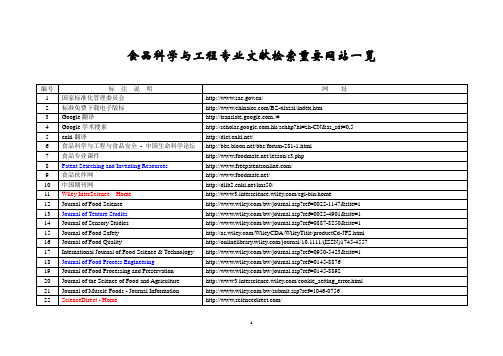
/kns50/
11
Wiley InterScience Home
/cgi-bin/home
12
Journal of Food Science
/bw/journal.asp?ref=0022-1147&site=1
/
53
食品科学网
/
54
食品专业课件网
/lesson/s3.php
55
食品行业标准网
/standard/
56
食品工程原理国家精品课程网
/home/main.mpx
39
/content/100491/?p=4ecea56071e649f2a0347ee90f43cf71&pi=0
40
/content/120800/
/
35
Food Research International
/science/journal/09639969
36
Food Chemistry
/science/journal/03088146
17
International Journal of Food Science & Technology
/bw/journal.asp?ref=0950-5423&site=1
18
Journal of Food Process Engineering
/bw/journal.asp?ref=0145-8876
29
Food Quality and Preference
/science/journal/09503293
30
Food Hydrocolloids
/science/journal/0268005X
论文翻译 高翔12-01
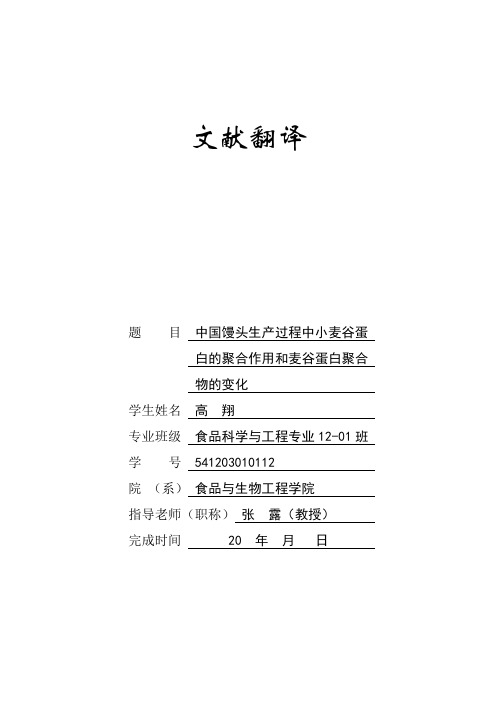
文献翻译题目中国馒头生产过程中小麦谷蛋白的聚合作用和麦谷蛋白聚合物的变化学生姓名高翔专业班级食品科学与工程专业12-01班学号541203010112 院(系)食品与生物工程学院指导老师(职称)张露(教授)完成时间 20 年月日中国馒头生产过程中小麦谷蛋白的聚合作用和麦谷蛋白聚合物的变化Xiang-Yu Wang,Xiao-Na Guo,Ke-Xue ZhuState Key Laboratory of Food Science and Technology, School of Food Science and Technology, Collaborative Innovation Center for Modern Grain Circulation and Safety, Jiangnan University, 1800 Lihu Avenue, Wuxi 214122, Jiangsu Province, PR China 摘要:研究了中国馒头生产过程中谷蛋白的聚合作用和麦谷蛋白聚合物的变化,为改善和控制CSB质量提供理论依据。
在面团的准备阶段,蛋白质的可萃取性和自由巯基(SH)的含量会增加到一定程度,但是在通入蒸汽后会有显著降低(P<0.05)。
同时,在十二烷基硫酸钠-聚丙烯酰氨凝胶电泳(SDS-PAGE)模式下,观测到大量的蛋白质聚合物。
通过激光扫描共聚焦显微镜,对气泡微观结构和蛋白质网络的研究,进一步揭示了连续和三维面筋网络的形成。
在面团的加工过程中,GMP湿重的损失和恢复是至关重要的(P<0.05)。
而麦谷蛋白的解聚作用与GMP湿重以及高分子量麦谷蛋白亚基(HMW-GS)和低分子量麦谷蛋白亚基(LMW-GS)的含量成负相关。
谷蛋白的聚合作用会导致GMP的G'和G''减少,而谷蛋白的解聚作用诱导GMP的G'和G''略有增加。
教学大纲-食品专业英语

《食品专业英语》课程教学大纲一.课程代号:03072204二.课程名称:食品专业英语三.学分:3学分学时:52 理论学时:52 实验学时:0四.课程性质:食品科学与工程专业(本科)的公共限选课五.先修课程:食品微生物学、食品生物化学、酶学、食品工艺学、营养与卫生学、烹饪、食品分析六.教学目标、教学要求:通过本课程教学,应使学生掌握专业英语的专业词汇,掌握专业英语的翻译方法,掌握专业英语科技文献阅读的基本技能,以胜任学生未来工作和继续发展的要求。
本课程要求学生:1.重点掌握食品营养卫生学、食品微生物学、酶学、食品发酵工艺学方面的专业词汇;2.了解专业英语的基本翻译语法要点;3.掌握专业科技文献阅读的基本要求。
七.教学内容:1.Lesson 1 Nutrition (4学时)Nutrition and Food: Definition;The Nutrients;Recommended Dietry Allowances;Margin of Safety Allows for Individual Differences;Differences in Nutrient Utilization Considered.基本要求:(1)句子结构分析;(2)连词and的译法;(3)翻译要点的运用:增译和减译、词类转译、后置定语和后置定语从句的译法等。
重点:运用翻译语法要点翻译复杂句。
难点:复杂句子的结构分析。
2.Lesson 2 Carbohydrates (6学时)Sources, Types, and Terminology;Carbohydrate Composition of Food.基本要求:(1)掌握关于碳水化合物方面专业词汇的构词法,如后缀-ose, -ulose, -an和前缀-glyc等;(2)运用翻译要点翻译句子。
重点:构词法。
难点:翻译要点的运用:句子成分转译和被动语态。
3.翻译方法(8学时)(1)构词法(2)单词(3)词类转换的译法(4)句子成分转换的译法(5)被动语态的译法(6)后置定语从句的译法(7)专业英语的主要特点和翻译标准基本要求:熟悉各种翻译要点。
ISO22002:2013食品安全中文版翻译

本文从网络收集而来,上传到平台为了帮到更多的人,如果您需要使用本文档,请点击下载,另外祝您生活愉快,工作顺利,万事如意!ISO22002:2013食品安全中文版翻译前言ISO(国际标准化组织)是一个由国家标准化机构组成的世界范围的联合会(ISO成员)。
制定国际标准的工作通常是由ISO技术委员会负责的。
每一个领域都有一支专业的技术委员会负责,每个成员国都有权代表技术委员会。
与ISO联络的政府性的和非政府性质的国际组织也参与ISO的工作。
ISO与国际电工委员会(IEC)在电器标准的各个方面有着密切合作。
介绍ISO 22000为处在食品供应链中的组织规定了具体的食品安全要求。
其中一个要求是组织建立、实施、保持前提方案(PRP),以协助控制食品安全危害(ISO 22000: 2005,7.2)。
除了ISO22000:2005,7.2的要求,这份技术说明还包括了ISO 22000:2005,5.6中的通讯要求。
ISO/TS 22002中这一章节的目的是用来支持管理系统的,设计此管理系统是为了达到ISO 22000中规定的具体要求,此章节为这些方案制定了详细的规定。
ISO/TS 22002中这一章节并不是复制ISO 22000中规定的要求,其目的是与ISO 22000联合使用,例如,这份技术说明中提出的为防止接触食品包装采取措施的有效性将被修订。
食品包装的预期用途需要被充分理解,由此通过设计合适的食品包装来鉴别处理食品安全风险,这些在此技术文件4.14章节中(食品包装信息和客户沟通)有所体现,遵守ISO 22000中的条款/分条款,如附件A所示。
食品安全前提方案-第四章食品包装制造业警告:这份技术声明中的内容假定由合格的有经验的目标用户委托执行。
此技术文件并不意指包括一份合同中的所有必要的规定。
用户负责正确使用这份文件。
遵照这份技术文件并不代表免除法律义务。
1.范围这份技术文件规定了建立、实施和保持前提方案(PRPs)的要求,以协助控制食品包装生产的食品安全危害。
微生物英文文献及翻译—原文
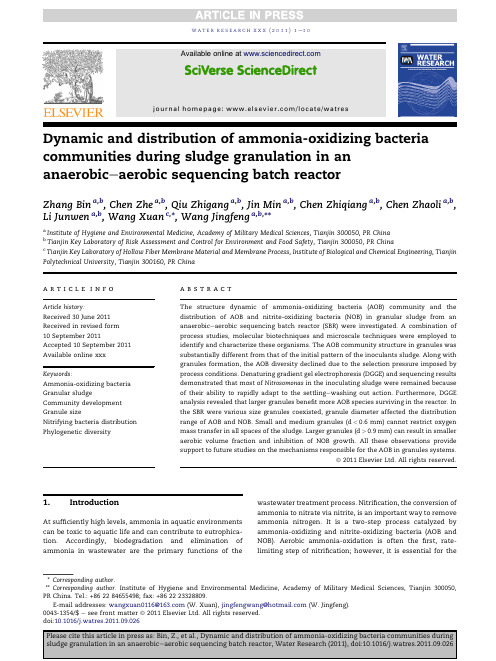
Dynamic and distribution of ammonia-oxidizing bacteria communities during sludge granulation in an anaerobic e aerobic sequencing batch reactorZhang Bin a ,b ,Chen Zhe a ,b ,Qiu Zhigang a ,b ,Jin Min a ,b ,Chen Zhiqiang a ,b ,Chen Zhaoli a ,b ,Li Junwen a ,b ,Wang Xuan c ,*,Wang Jingfeng a ,b ,**aInstitute of Hygiene and Environmental Medicine,Academy of Military Medical Sciences,Tianjin 300050,PR China bTianjin Key Laboratory of Risk Assessment and Control for Environment and Food Safety,Tianjin 300050,PR China cTianjin Key Laboratory of Hollow Fiber Membrane Material and Membrane Process,Institute of Biological and Chemical Engineering,Tianjin Polytechnical University,Tianjin 300160,PR Chinaa r t i c l e i n f oArticle history:Received 30June 2011Received in revised form 10September 2011Accepted 10September 2011Available online xxx Keywords:Ammonia-oxidizing bacteria Granular sludgeCommunity development Granule sizeNitrifying bacteria distribution Phylogenetic diversitya b s t r a c tThe structure dynamic of ammonia-oxidizing bacteria (AOB)community and the distribution of AOB and nitrite-oxidizing bacteria (NOB)in granular sludge from an anaerobic e aerobic sequencing batch reactor (SBR)were investigated.A combination of process studies,molecular biotechniques and microscale techniques were employed to identify and characterize these organisms.The AOB community structure in granules was substantially different from that of the initial pattern of the inoculants sludge.Along with granules formation,the AOB diversity declined due to the selection pressure imposed by process conditions.Denaturing gradient gel electrophoresis (DGGE)and sequencing results demonstrated that most of Nitrosomonas in the inoculating sludge were remained because of their ability to rapidly adapt to the settling e washing out action.Furthermore,DGGE analysis revealed that larger granules benefit more AOB species surviving in the reactor.In the SBR were various size granules coexisted,granule diameter affected the distribution range of AOB and NOB.Small and medium granules (d <0.6mm)cannot restrict oxygen mass transfer in all spaces of the rger granules (d >0.9mm)can result in smaller aerobic volume fraction and inhibition of NOB growth.All these observations provide support to future studies on the mechanisms responsible for the AOB in granules systems.ª2011Elsevier Ltd.All rights reserved.1.IntroductionAt sufficiently high levels,ammonia in aquatic environments can be toxic to aquatic life and can contribute to eutrophica-tion.Accordingly,biodegradation and elimination of ammonia in wastewater are the primary functions of thewastewater treatment process.Nitrification,the conversion of ammonia to nitrate via nitrite,is an important way to remove ammonia nitrogen.It is a two-step process catalyzed by ammonia-oxidizing and nitrite-oxidizing bacteria (AOB and NOB).Aerobic ammonia-oxidation is often the first,rate-limiting step of nitrification;however,it is essential for the*Corresponding author .**Corresponding author.Institute of Hygiene and Environmental Medicine,Academy of Military Medical Sciences,Tianjin 300050,PR China.Tel.:+862284655498;fax:+862223328809.E-mail addresses:wangxuan0116@ (W.Xuan),jingfengwang@ (W.Jingfeng).Available online atjournal homepage:/locate/watresw a t e r r e s e a r c h x x x (2011)1e 100043-1354/$e see front matter ª2011Elsevier Ltd.All rights reserved.doi:10.1016/j.watres.2011.09.026removal of ammonia from the wastewater(Prosser and Nicol, 2008).Comparative analyses of16S rRNA sequences have revealed that most AOB in activated sludge are phylogeneti-cally closely related to the clade of b-Proteobacteria (Kowalchuk and Stephen,2001).However,a number of studies have suggested that there are physiological and ecological differences between different AOB genera and lineages,and that environmental factors such as process parameter,dis-solved oxygen,salinity,pH,and concentrations of free ammonia can impact certain species of AOB(Erguder et al., 2008;Kim et al.,2006;Koops and Pommerening-Ro¨ser,2001; Kowalchuk and Stephen,2001;Shi et al.,2010).Therefore, the physiological activity and abundance of AOB in waste-water processing is critical in the design and operation of waste treatment systems.For this reason,a better under-standing of the ecology and microbiology of AOB in waste-water treatment systems is necessary to enhance treatment performance.Recently,several developed techniques have served as valuable tools for the characterization of microbial diversity in biological wastewater treatment systems(Li et al., 2008;Yin and Xu,2009).Currently,the application of molec-ular biotechniques can provide clarification of the ammonia-oxidizing community in detail(Haseborg et al.,2010;Tawan et al.,2005;Vlaeminck et al.,2010).In recent years,the aerobic granular sludge process has become an attractive alternative to conventional processes for wastewater treatment mainly due to its cell immobilization strategy(de Bruin et al.,2004;Liu et al.,2009;Schwarzenbeck et al.,2005;Schwarzenbeck et al.,2004a,b;Xavier et al.,2007). Granules have a more tightly compact structure(Li et al.,2008; Liu and Tay,2008;Wang et al.,2004)and rapid settling velocity (Kong et al.,2009;Lemaire et al.,2008).Therefore,granular sludge systems have a higher mixed liquid suspended sludge (MLSS)concentration and longer solid retention times(SRT) than conventional activated sludge systems.Longer SRT can provide enough time for the growth of organisms that require a long generation time(e.g.,AOB).Some studies have indicated that nitrifying granules can be cultivated with ammonia-rich inorganic wastewater and the diameter of granules was small (Shi et al.,2010;Tsuneda et al.,2003).Other researchers reported that larger granules have been developed with the synthetic organic wastewater in sequencing batch reactors(SBRs)(Li et al., 2008;Liu and Tay,2008).The diverse populations of microor-ganisms that coexist in granules remove the chemical oxygen demand(COD),nitrogen and phosphate(de Kreuk et al.,2005). However,for larger granules with a particle diameter greater than0.6mm,an outer aerobic shell and an inner anaerobic zone coexist because of restricted oxygen diffusion to the granule core.These properties of granular sludge suggest that the inner environment of granules is unfavorable to AOB growth.Some research has shown that particle size and density induced the different distribution and dominance of AOB,NOB and anam-mox(Winkler et al.,2011b).Although a number of studies have been conducted to assess the ecology and microbiology of AOB in wastewater treatment systems,the information on the dynamics,distribution,and quantification of AOB communities during sludge granulation is still limited up to now.To address these concerns,the main objective of the present work was to investigate the population dynamics of AOB communities during the development of seedingflocs into granules,and the distribution of AOB and NOB in different size granules from an anaerobic e aerobic SBR.A combination of process studies,molecular biotechniques and microscale techniques were employed to identify and char-acterize these organisms.Based on these approaches,we demonstrate the differences in both AOB community evolu-tion and composition of theflocs and granules co-existing in the SBR and further elucidate the relationship between distribution of nitrifying bacteria and granule size.It is ex-pected that the work would be useful to better understand the mechanisms responsible for the AOB in granules and apply them for optimal control and management strategies of granulation systems.2.Material and methods2.1.Reactor set-up and operationThe granules were cultivated in a lab-scale SBR with an effective volume of4L.The effective diameter and height of the reactor was10cm and51cm,respectively.The hydraulic retention time was set at8h.Activated sludge from a full-scale sewage treat-ment plant(Jizhuangzi Sewage Treatment Works,Tianjin, China)was used as the seed sludge for the reactor at an initial sludge concentration of3876mg LÀ1in MLSS.The reactor was operated on6-h cycles,consisting of2-min influent feeding,90-min anaerobic phase(mixing),240-min aeration phase and5-min effluent discharge periods.The sludge settling time was reduced gradually from10to5min after80SBR cycles in20days, and only particles with a settling velocity higher than4.5m hÀ1 were retained in the reactor.The composition of the influent media were NaAc(450mg LÀ1),NH4Cl(100mg LÀ1),(NH4)2SO4 (10mg LÀ1),KH2PO4(20mg LÀ1),MgSO4$7H2O(50mg LÀ1),KCl (20mg LÀ1),CaCl2(20mg LÀ1),FeSO4$7H2O(1mg LÀ1),pH7.0e7.5, and0.1mL LÀ1trace element solution(Li et al.,2007).Analytical methods-The total organic carbon(TOC),NHþ4e N, NOÀ2e N,NOÀ3e N,total nitrogen(TN),total phosphate(TP) concentration,mixed liquid suspended solids(MLSS) concentration,and sludge volume index at10min(SVI10)were measured regularly according to the standard methods (APHA-AWWA-WEF,2005).Sludge size distribution was determined by the sieving method(Laguna et al.,1999).Screening was performed with four stainless steel sieves of5cm diameter having respective mesh openings of0.9,0.6,0.45,and0.2mm.A100mL volume of sludge from the reactor was sampled with a calibrated cylinder and then deposited on the0.9mm mesh sieve.The sample was subsequently washed with distilled water and particles less than0.9mm in diameter passed through this sieve to the sieves with smaller openings.The washing procedure was repeated several times to separate the gran-ules.The granules collected on the different screens were recovered by backwashing with distilled water.Each fraction was collected in a different beaker andfiltered on quantitative filter paper to determine the total suspended solid(TSS).Once the amount of total suspended solid(TSS)retained on each sieve was acquired,it was reasonable to determine for each class of size(<0.2,[0.2e0.45],[0.45e0.6],[0.6e0.9],>0.9mm) the percentage of the total weight that they represent.w a t e r r e s e a r c h x x x(2011)1e10 22.2.DNA extraction and nested PCR e DGGEThe sludge from approximately8mg of MLSS was transferred into a1.5-mL Eppendorf tube and then centrifuged at14,000g for10min.The supernatant was removed,and the pellet was added to1mL of sodium phosphate buffer solution and aseptically mixed with a sterilized pestle in order to detach granules.Genomic DNA was extracted from the pellets using E.Z.N.A.äSoil DNA kit(D5625-01,Omega Bio-tek Inc.,USA).To amplify ammonia-oxidizer specific16S rRNA for dena-turing gradient gel electrophoresis(DGGE),a nested PCR approach was performed as described previously(Zhang et al., 2010).30m l of nested PCR amplicons(with5m l6Âloading buffer)were loaded and separated by DGGE on polyacrylamide gels(8%,37.5:1acrylamide e bisacrylamide)with a linear gradient of35%e55%denaturant(100%denaturant¼7M urea plus40%formamide).The gel was run for6.5h at140V in 1ÂTAE buffer(40mM Tris-acetate,20mM sodium acetate, 1mM Na2EDTA,pH7.4)maintained at60 C(DCodeäUniversal Mutation Detection System,Bio-Rad,Hercules,CA, USA).After electrophoresis,silver-staining and development of the gels were performed as described by Sanguinetti et al. (1994).These were followed by air-drying and scanning with a gel imaging analysis system(Image Quant350,GE Inc.,USA). The gel images were analyzed with the software Quantity One,version4.31(Bio-rad).Dice index(Cs)of pair wise community similarity was calculated to evaluate the similarity of the AOB community among DGGE lanes(LaPara et al.,2002).This index ranges from0%(no common band)to100%(identical band patterns) with the assistance of Quantity One.The Shannon diversity index(H)was used to measure the microbial diversity that takes into account the richness and proportion of each species in a population.H was calculatedusing the following equation:H¼ÀPn iNlogn iN,where n i/Nis the proportion of community made up by species i(bright-ness of the band i/total brightness of all bands in the lane).Dendrograms relating band pattern similarities were automatically calculated without band weighting(consider-ation of band density)by the unweighted pair group method with arithmetic mean(UPGMA)algorithms in the Quantity One software.Prominent DGGE bands were excised and dissolved in30m L Milli-Q water overnight,at4 C.DNA was recovered from the gel by freeze e thawing thrice.Cloning and sequencing of the target DNA fragments were conducted following the estab-lished method(Zhang et al.,2010).2.3.Distribution of nitrifying bacteriaThree classes of size([0.2e0.45],[0.45e0.6],>0.9mm)were chosen on day180for FISH analysis in order to investigate the spatial distribution characteristics of AOB and NOB in granules.2mg sludge samples werefixed in4%para-formaldehyde solution for16e24h at4 C and then washed twice with sodium phosphate buffer;the samples were dehydrated in50%,80%and100%ethanol for10min each. Ethanol in the granules was then completely replaced by xylene by serial immersion in ethanol-xylene solutions of3:1, 1:1,and1:3by volume andfinally in100%xylene,for10min periods at room temperature.Subsequently,the granules were embedded in paraffin(m.p.56e58 C)by serial immer-sion in1:1xylene-paraffin for30min at60 C,followed by 100%paraffin.After solidification in paraffin,8-m m-thick sections were prepared and placed on gelatin-coated micro-scopic slides.Paraffin was removed by immersing the slide in xylene and ethanol for30min each,followed by air-drying of the slides.The three oligonucleotide probes were used for hybridiza-tion(Downing and Nerenberg,2008):FITC-labeled Nso190, which targets the majority of AOB;TRITC-labeled NIT3,which targets Nitrobacter sp.;TRITC-labeled NSR1156,which targets Nitrospira sp.All probe sequences,their hybridization condi-tions,and washing conditions are given in Table1.Oligonu-cleotides were synthesized andfluorescently labeled with fluorochomes by Takara,Inc.(Dalian,China).Hybridizations were performed at46 C for2h with a hybridization buffer(0.9M NaCl,formamide at the percentage shown in Table1,20mM Tris/HCl,pH8.0,0.01% SDS)containing each labeled probe(5ng m LÀ1).After hybrid-ization,unbound oligonucleotides were removed by a strin-gent washing step at48 C for15min in washing buffer containing the same components as the hybridization buffer except for the probes.For detection of all DNA,4,6-diamidino-2-phenylindole (DAPI)was diluted with methanol to afinal concentration of1ng m LÀ1.Cover the slides with DAPI e methanol and incubate for15min at37 C.The slides were subsequently washed once with methanol,rinsed briefly with ddH2O and immediately air-dried.Vectashield(Vector Laboratories)was used to prevent photo bleaching.The hybridization images were captured using a confocal laser scanning microscope (CLSM,Zeiss710).A total of10images were captured for each probe at each class of size.The representative images were selected andfinal image evaluation was done in Adobe PhotoShop.w a t e r r e s e a r c h x x x(2011)1e1033.Results3.1.SBR performance and granule characteristicsDuring the startup period,the reactor removed TOC and NH 4þ-N efficiently.98%of NH 4þ-N and 100%of TOC were removed from the influent by day 3and day 5respectively (Figs.S2,S3,Supporting information ).Removal of TN and TP were lower during this period (Figs.S3,S4,Supporting information ),though the removal of TP gradually improved to 100%removal by day 33(Fig.S4,Supporting information ).To determine the sludge volume index of granular sludge,a settling time of 10min was chosen instead of 30min,because granular sludge has a similar SVI after 60min and after 5min of settling (Schwarzenbeck et al.,2004b ).The SVI 10of the inoculating sludge was 108.2mL g À1.The changing patterns of MLSS and SVI 10in the continuous operation of the SBR are illustrated in Fig.1.The sludge settleability increased markedly during the set-up period.Fig.2reflects the slow andgradual process of sludge granulation,i.e.,from flocculentsludge to granules.3.2.DGGE analysis:AOB communities structure changes during sludge granulationThe results of nested PCR were shown in Fig.S1.The well-resolved DGGE bands were obtained at the representative points throughout the GSBR operation and the patterns revealed that the structure of the AOB communities was dynamic during sludge granulation and stabilization (Fig.3).The community structure at the end of experiment was different from that of the initial pattern of the seed sludge.The AOB communities on day 1showed 40%similarity only to that at the end of the GSBR operation (Table S1,Supporting information ),indicating the considerable difference of AOB communities structures between inoculated sludge and granular sludge.Biodiversity based on the DGGE patterns was analyzed by calculating the Shannon diversity index H as204060801001201401254159738494104115125135147160172188Time (d)S V I 10 (m L .g -1)10002000300040005000600070008000900010000M L S S (m g .L -1)Fig.1e Change in biomass content and SVI 10during whole operation.SVI,sludge volume index;MLSS,mixed liquid suspendedsolids.Fig.2e Variation in granule size distribution in the sludge during operation.d,particle diameter;TSS,total suspended solids.w a t e r r e s e a r c h x x x (2011)1e 104shown in Fig.S5.In the phase of sludge inoculation (before day 38),H decreased remarkably (from 0.94to 0.75)due to the absence of some species in the reactor.Though several dominant species (bands2,7,10,11)in the inoculating sludge were preserved,many bands disappeared or weakened (bands 3,4,6,8,13,14,15).After day 45,the diversity index tended to be stable and showed small fluctuation (from 0.72to 0.82).Banding pattern similarity was analyzed by applying UPGMA (Fig.4)algorithms.The UPGMA analysis showed three groups with intragroup similarity at approximately 67%e 78%and intergroup similarity at 44e 62%.Generally,the clustering followed the time course;and the algorithms showed a closer clustering of groups II and III.In the analysis,group I was associated with sludge inoculation and washout,group IIwithFig.3e DGGE profile of the AOB communities in the SBR during the sludge granulation process (lane labels along the top show the sampling time (days)from startup of the bioreactor).The major bands were labeled with the numbers (bands 1e15).Fig.4e UPGMA analysis dendrograms of AOB community DGGE banding patterns,showing schematics of banding patterns.Roman numerals indicate major clusters.w a t e r r e s e a r c h x x x (2011)1e 105startup sludge granulation and decreasing SVI 10,and group III with a stable system and excellent biomass settleability.In Fig.3,the locations of the predominant bands were excised from the gel.DNA in these bands were reamplified,cloned and sequenced.The comparative analysis of these partial 16S rRNA sequences (Table 2and Fig.S6)revealed the phylogenetic affiliation of 13sequences retrieved.The majority of the bacteria in seed sludge grouped with members of Nitrosomonas and Nitrosospira .Along with sludge granula-tion,most of Nitrosomonas (Bands 2,5,7,9,10,11)were remained or eventually became dominant in GSBR;however,all of Nitrosospira (Bands 6,13,15)were gradually eliminated from the reactor.3.3.Distribution of AOB and NOB in different sized granulesFISH was performed on the granule sections mainly to deter-mine the location of AOB and NOB within the different size classes of granules,and the images were not further analyzed for quantification of cell counts.As shown in Fig.6,in small granules (0.2mm <d <0.45mm),AOB located mainly in the outer part of granular space,whereas NOB were detected only in the core of granules.In medium granules (0.45mm <d <0.6mm),AOB distributed evenly throughout the whole granular space,whereas NOB still existed in the inner part.In the larger granules (d >0.9mm),AOB and NOB were mostly located in the surface area of the granules,and moreover,NOB became rare.4.Discussion4.1.Relationship between granule formation and reactor performanceAfter day 32,the SVI 10stabilized at 20e 35mL g À1,which is very low compared to the values measured for activated sludge (100e 150mL g À1).However,the size distribution of the granules measured on day 32(Fig.2)indicated that only 22%of the biomass was made of granular sludge with diameter largerthan 0.2mm.These results suggest that sludge settleability increased prior to granule formation and was not affected by different particle sizes in the sludge during the GSBR operation.It was observed,however,that the diameter of the granules fluctuated over longer durations.The large granules tended to destabilize due to endogenous respiration,and broke into smaller granules that could seed the formation of large granules again.Pochana and Keller reported that physically broken sludge flocs contribute to lower denitrification rates,due to their reduced anoxic zone (Pochana and Keller,1999).Therefore,TN removal efficiency raises fluctuantly throughout the experiment.Some previous research had demonstrated that bigger,more dense granules favored the enrichment of PAO (Winkler et al.,2011a ).Hence,after day 77,removal efficiency of TP was higher and relatively stable because the granules mass fraction was over 90%and more larger granules formed.4.2.Relationship between AOB communities dynamic and sludge granulationFor granule formation,a short settling time was set,and only particles with a settling velocity higher than 4.5m h À1were retained in the reactor.Moreover,as shown in Fig.1,the variation in SVI 10was greater before day 41(from 108.2mL g À1e 34.1mL g À1).During this phase,large amounts of biomass could not survive in the reactor.A clear shift in pop-ulations was evident,with 58%similarity between days 8and 18(Table S1).In the SBR system fed with acetate-based synthetic wastewater,heterotrophic bacteria can produce much larger amounts of extracellular polysaccharides than autotrophic bacteria (Tsuneda et al.,2003).Some researchers found that microorganisms in high shear environments adhered by extracellular polymeric substances (EPS)to resist the damage of suspended cells by environmental forces (Trinet et al.,1991).Additionally,it had been proved that the dominant heterotrophic species in the inoculating sludge were preserved throughout the process in our previous research (Zhang et al.,2011).It is well known that AOB are chemoau-totrophic and slow-growing;accordingly,numerous AOBw a t e r r e s e a r c h x x x (2011)1e 106populations that cannot become big and dense enough to settle fast were washed out from the system.As a result,the variation in AOB was remarkable in the period of sludge inoculation,and the diversity index of population decreased rapidly.After day 45,AOB communities’structure became stable due to the improvement of sludge settleability and the retention of more biomass.These results suggest that the short settling time (selection pressure)apparently stressed the biomass,leading to a violent dynamic of AOB communities.Further,these results suggest that certain populations may have been responsible for the operational success of the GSBR and were able to persist despite the large fluctuations in pop-ulation similarity.This bacterial population instability,coupled with a generally acceptable bioreactor performance,is congruent with the results obtained from a membrane biore-actor (MBR)for graywater treatment (Stamper et al.,2003).Nitrosomonas e like and Nitrosospira e like populations are the dominant AOB populations in wastewater treatment systems (Kowalchuk and Stephen,2001).A few previous studies revealed that the predominant populations in AOB communities are different in various wastewater treatment processes (Tawan et al.,2005;Thomas et al.,2010).Some researchers found that the community was dominated by AOB from the genus Nitrosospira in MBRs (Zhang et al.,2010),whereas Nitrosomonas sp.is the predominant population in biofilter sludge (Yin and Xu,2009).In the currentstudy,Fig.5e DGGE profile of the AOB communities in different size of granules (lane labels along the top show the range of particle diameter (d,mm)).Values along the bottom indicate the Shannon diversity index (H ).Bands labeled with the numbers were consistent with the bands in Fig.3.w a t e r r e s e a r c h x x x (2011)1e 107sequence analysis revealed that selection pressure evidently effect on the survival of Nitrosospira in granular sludge.Almost all of Nitrosospira were washed out initially and had no chance to evolve with the environmental changes.However,some members of Nitrosomonas sp.have been shown to produce more amounts of EPS than Nitrosospira ,especially under limited ammonia conditions (Stehr et al.,1995);and this feature has also been observed for other members of the same lineage.Accordingly,these EPS are helpful to communicate cells with each other and granulate sludge (Adav et al.,2008).Therefore,most of Nitrosomonas could adapt to this challenge (to become big and dense enough to settle fast)and were retained in the reactor.At the end of reactor operation (day 180),granules with different particle size were sieved.The effects of variation in granules size on the composition of the AOBcommunitiesFig.6e Micrographs of FISH performed on three size classes of granule sections.DAPI stain micrographs (A,D,G);AOB appear as green fluorescence (B,E,H),and NOB appear as red fluorescence (C,F,I).Bar [100m m in (A)e (C)and (G)e (I).d,particle diameter.(For interpretation of the references to colour in this figure legend,the reader is referred to the web version of this article.)w a t e r r e s e a r c h x x x (2011)1e 108were investigated.As shown in Fig.5,AOB communities structures in different size of granules were varied.Although several predominant bands(bands2,5,11)were present in all samples,only bands3and6appeared in the granules with diameters larger than0.6mm.Additionally,bands7and10 were intense in the granules larger than0.45mm.According to Table2,it can be clearly indicated that Nitrosospira could be retained merely in the granules larger than0.6mm.Therefore, Nitrosospira was not present at a high level in Fig.3due to the lower proportion of larger granules(d>0.6mm)in TSS along with reactor operation.DGGE analysis also revealed that larger granules had a greater microbial diversity than smaller ones. This result also demonstrates that more organisms can survive in larger granules as a result of more space,which can provide the suitable environment for the growth of microbes(Fig.6).4.3.Effect of variance in particle size on the distribution of AOB and NOB in granulesAlthough an influence of granule size has been observed in experiments and simulations for simultaneous N-and P-removal(de Kreuk et al.,2007),the effect of granule size on the distribution of different biomass species need be revealed further with the assistance of visible experimental results, especially in the same granular sludge reactors.Related studies on the diversity of bacterial communities in granular sludge often focus on the distribution of important functional bacteria populations in single-size granules(Matsumoto et al., 2010).In the present study,different size granules were sieved,and the distribution patterns of AOB and NOB were explored.In the nitrification processes considered,AOB and NOB compete for space and oxygen in the granules(Volcke et al.,2010).Since ammonium oxidizers have a higheroxygen affinity(K AOBO2<K NOBO2)and accumulate more rapidly inthe reactor than nitrite oxidizers(Volcke et al.,2010),NOB are located just below the layer of AOB,where still some oxygen is present and allows ready access to the nitrite produced.In smaller granules,the location boundaries of the both biomass species were distinct due to the limited existence space provided by granules for both microorganism’s growth.AOB exist outside of the granules where oxygen and ammonia are present.Medium granules can provide broader space for microbe multiplying;accordingly,AOB spread out in the whole granules.This result also confirms that oxygen could penetrate deep into the granule’s core without restriction when particle diameter is less than0.6mm.Some mathematic model also supposed that NOBs are favored to grow in smaller granules because of the higher fractional aerobic volume (Volcke et al.,2010).As shown in the results of the batch experiments(Zhang et al.,2011),nitrite accumulation temporarily occurred,accompanied by the more large gran-ules(d>0.9mm)forming.This phenomenon can be attrib-uted to the increased ammonium surface load associated with larger granules and smaller aerobic volume fraction,resulting in outcompetes of NOB.It also suggests that the core areas of large granules(d>0.9mm)could provide anoxic environment for the growth of anaerobic denitrificans(such as Tb.deni-trificans or Tb.thioparus in Fig.S7,Supporting information).As shown in Fig.2and Fig.S3,the removal efficiency of total nitrogen increased with formation of larger granules.5.ConclusionsThe variation in AOB communities’structure was remarkable during sludge inoculation,and the diversity index of pop-ulation decreased rapidly.Most of Nitrosomonas in the inocu-lating sludge were retained because of their capability to rapidly adapt to the settling e washing out action.DGGE anal-ysis also revealed that larger granules had greater AOB diversity than that of smaller ones.Oxygen penetration was not restricted in the granules of less than0.6mm particle diameter.However,the larger granules(d>0.9mm)can result in the smaller aerobic volume fraction and inhibition of NOB growth.Henceforth,further studies on controlling and opti-mizing distribution of granule size could be beneficial to the nitrogen removal and expansive application of granular sludge technology.AcknowledgmentsThis work was supported by grants from the National Natural Science Foundation of China(No.51108456,50908227)and the National High Technology Research and Development Program of China(No.2009AA06Z312).Appendix.Supplementary dataSupplementary data associated with this article can be found in online version at doi:10.1016/j.watres.2011.09.026.r e f e r e n c e sAdav,S.S.,Lee, D.J.,Show,K.Y.,2008.Aerobic granular sludge:recent advances.Biotechnology Advances26,411e423.APHA-AWWA-WEF,2005.Standard Methods for the Examination of Water and Wastewater,first ed.American Public Health Association/American Water Works Association/WaterEnvironment Federation,Washington,DC.de Bruin,L.M.,de Kreuk,M.,van der Roest,H.F.,Uijterlinde,C., van Loosdrecht,M.C.M.,2004.Aerobic granular sludgetechnology:an alternative to activated sludge?Water Science and Technology49,1e7.de Kreuk,M.,Heijnen,J.J.,van Loosdrecht,M.C.M.,2005.Simultaneous COD,nitrogen,and phosphate removal byaerobic granular sludge.Biotechnology and Bioengineering90, 761e769.de Kreuk,M.,Picioreanu,C.,Hosseini,M.,Xavier,J.B.,van Loosdrecht,M.C.M.,2007.Kinetic model of a granular sludge SBR:influences on nutrient removal.Biotechnology andBioengineering97,801e815.Downing,L.S.,Nerenberg,R.,2008.Total nitrogen removal ina hybrid,membrane-aerated activated sludge process.WaterResearch42,3697e3708.Erguder,T.H.,Boon,N.,Vlaeminck,S.E.,Verstraete,W.,2008.Partial nitrification achieved by pulse sulfide doses ina sequential batch reactor.Environmental Science andTechnology42,8715e8720.w a t e r r e s e a r c h x x x(2011)1e109。
食品专业文献导读课程论文及要求

《食品专业文献导读》课程论文题名:英文题名:姓名:学号:学院:班级:指导教师:20 年月日一、课题内容分析1、涉及学科领域:__ ____(提供涉及的不少于三种的技术领域,并说明该技术领域主要学科方向。
)2、研究内容(通过文献的检索和阅读,撰写你所选课题方向研究的主要内容及要解决的关键性问题,字数在200-300字之间):3、中英文关键词(分别不得少于3个,英文关键词允许是中文的英译):中文关键词:英文关键词:4、中英文逻辑检索表达式(提供检索表达式的组配方式不少于3种):中文检索表达式:①;②;③。
英文检索表达式:①;②;③。
二、选择检索工具并检索、记录、整理检索结果1、检索工具及检索结果:(1)中国知网之中国学术期刊全文数据库(检索时间范围:2000-2012)检索过程:采用检索表达式①,检索结果篇;采用检索表达式②,检索结果篇;采用检索表达式③,检索结果篇。
检索分析:通过检索结果的比较和分析,该课题的标准检索表达式为:(在检索词后用括号注明检索字段),检索结果为篇文献。
(2)万方数据知识服务平台(检索时间范围:2000-2012)检索过程:采用检索表达式①,检索结果篇;采用检索表达式②,检索结果篇;采用检索表达式③,检索结果篇。
检索分析:通过检索结果的比较和分析,该课题的标准检索表达式为:(在检索词后用括号注明检索字段),检索结果为篇文献。
(3)重庆维普资源系统(检索时间范围:2000-2012,检索模式:内容检索)检索过程:采用检索表达式①,检索结果篇;采用检索表达式②,检索结果篇;采用检索表达式③,检索结果篇。
检索分析:通过检索结果的比较和分析,该课题的标准检索表达式为:(在检索词后用括号注明检索字段),检索结果为篇文献。
(4)爱思唯尔英文期刊全文数据库(Elsevier SD)(检索时间范围:2000-2012)检索过程:采用检索表达式①,检索结果篇;采用检索表达式②,检索结果篇;采用检索表达式③,检索结果篇。
食品包装外文翻译文献中英文
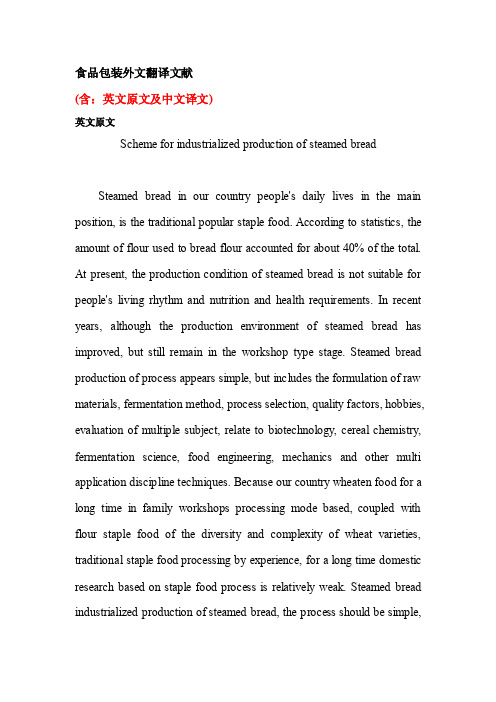
食品包装外文翻译文献(含:英文原文及中文译文)英文原文Scheme for industrialized production of steamed breadSteamed bread in our country people's daily lives in the main position, is the traditional popular staple food. According to statistics, the amount of flour used to bread flour accounted for about 40% of the total. At present, the production condition of steamed bread is not suitable for people's living rhythm and nutrition and health requirements. In recent years, although the production environment of steamed bread has improved, but still remain in the workshop type stage. Steamed bread production of process appears simple, but includes the formulation of raw materials, fermentation method, process selection, quality factors, hobbies, evaluation of multiple subject, relate to biotechnology, cereal chemistry, fermentation science, food engineering, mechanics and other multi application discipline techniques. Because our country wheaten food for a long time in family workshops processing mode based, coupled with flour staple food of the diversity and complexity of wheat varieties, traditional staple food processing by experience, for a long time domestic research based on staple food process is relatively weak. Steamed bread industrialized production of steamed bread, the process should be simple,continuous, fast and efficient. Therefore, after the fermentation process, then neutralizing the forming. Process is as follows: Flour + water + yeast and fermentation < doped mixing > forming a shaping a discharge a Xing hair a steaming a product cooling packaging.Staple food steamed bread industry will drive the industrialization of other Chinese traditional pasta, promote related industries the development of as traditional staple food, steamed bread, dumplings, noodles, as the main raw materials are flour, in mechanism research and application research have many similarities and differences. Such as easy to aging, easy to mildew and other issues in the flour food ubiquitous, is caused by flour food shelf life is short, not easy to store the main reason that restrict the circulation radius of flour food. To capture the steamed bread aging resistance, mildew key technologies, to solve dumplings, noodles and other food related issues, many varieties of Chinese traditional food industry of have a strong reference, for the comprehensive development of nearly 200 billion yuan of the industrialization of staple food market has a positive role in promoting. Also the staple food industrialization involves the national economy of our country the first, the second and third industry, the industrial chain relates to grow wheat, flour processing, food processing, food service industry, mechanical design and processing, testing equipment, such as related industries, driven by industry, the scientific and technologicallevel of the related industries, relevant industry labor productivity and international competitiveness of the market existing production equipment steamed bread simply copy the handmade process to improve. However, due to the surface and mechanical stirring strength is greater, forming the spiral extrusion would seriously undermine the strength of dough, the dough in the machining process temperature rise too higher defect is the steamed bread machine processing beyond the main reason for the comprehensive quality of bread by hand. Steamed Buns is also involved in biotechnology, cereal chemistry, fermentation, food engineering, mechanics and other application technology.At present, as the unique Chinese characteristics of traditional food safety and health, China has introduced the world's interest in steamed bread. In recent years, Europe and the United States food companies and research institutions have set off a boom in the study of Chinese steamed bread.Industry of Chinese steamed bread is in the workshop and intensive chemical plant to the industrialization and industrialization development is an important transition period, the scientific research community and the industry is bound to see tremendous market potential in the future, thereby increasing the intensity of the use of scientific research investment and high technology, especially in the use of modern science and technology discovery and maintenance of traditional craft productionof the unique flavor of bread at the same time, will gradually raise the production automation and mechanization. Because the way to rely on a large number of artificial production can not adapt to the growing tension of human resources in China, but also does not meet the requirements of safety and health of consumers. Through the implementation of the promotion of staple food steamed bread industrialization projects, will lead a batch of products of good quality, high technology content, strong market competitiveness of enterprises are booming, gradually replace the workshops and other backward processing methods, further improve the industrial concentration and the core competitiveness.Development of steamed bread machine relates to food engineering, fermentation theory, mechanical design, multi applied science and technology, and requires a lot of food based on research results do support. Therefore Engineering Center has established a special flour food machinery research, by the technology personnel and mechanical design personnel together, in the development of steamed bread in the process of the equipment, engineering center make full use of the accumulated over the years the scientific research in wheat, flour, flour food, in the in-depth study of traditional handmade bread and surface, forming, baking, steaming process principle of system based on, according to scientific industrialization production process requirements for mechanical design, the hand-made steamed bread shaping method is successfully simulatedby using intelligent bionics technology. And on this basis for a series of technical innovationWheat flour is the main raw material for the production of steamed bread, and the protein content of the steamed bread production process and the quality of steamed bread have a great impact. Rheological measurement showed that the content of wet gluten flour in the production of 39.7% or so steamed bread is better. This process of dough, good quality, good air, moderate strength, surface color Steamed Buns white, thin silk. The internal structure is small and flexible honeycomb layers. With high gluten content of flour production, although the volume of steamed bread, but the fermentation time is long, the surface of the finished product surface color, there are blisters. The volume is smaller than 60% Steamed Buns gluten content in wheat flour, the internal honeycomb structure is rough, poor flavor.Plays an important role in the process of production of steamed bread fermentation of steamed bread production process of fermentation, fermentation quality will directly affect the steamed bread quality and nutrient composition, fermentation is using the yeast flour sugar and other nutrients alcohol fermentation to produce CO2 and alcohol, the dough swelling loose and flexible. With the dough fermentation, lactic acid and acetic acid, such as lactic acid and acetic acid, can also be produced by lactic acid and acetic acid. Alcohol and acid can be combined into estersof aromatic substances, aromatic flavor. Therefore, alcohol, organic acids and esters are important substances Steamed Buns produce wine, sweet dough. If the fermentation time is long, also can form aldehyde, ketone and so on carbonyl compound, they are also the important flavor substance. The temperature, humidity, time and the protein content of flour should be controlled strictly in the process of dough fermentation.Double roller spiral forming Steamed Buns used rub finish forming machine. Its working principle is by motor starting will and good fermentation of dough into surface feed bucket inner feeder cast will shape the dough into a packing auger, and the introduction of dough extruding mouth rotary cutting knife cut into uniform size of dough, and turn into a twin roll type forming groove. Fermentation under the screw driven rapidly knead the dough into feed hopper, feeder cast will shape the dough into a packing auger, and launched crowded mouth rotary rubbing to form a smooth surface spherical dough blank. If you need a different shape, a specially designed auxiliary device to achieve the weight of billet surface by an adjusting device set. The double roller forming machine theory error, leave some blank dough spin marks affect the quality of the finished appearance. And set up a plastic machine to be eliminated. The spherical twist ratio of height to diameter greater than the green cylinder, and then become the steaming process thoroughly smooth spherical. The production of key equipment Steamed BunsOne is to solve the problem of labor intensity, the two is to ensure product hygiene, three are automatically arranged accurately, to avoid sticking to the skin. Dial plate discharge machine.The plate-type discharge machine feeds the formed dough to the discharge machine at a certain distance from the conveyor belt. The upper part of the discharge machine is provided with a rotating carboxylate plate, and the direction of rotation of the plate is perpendicular to the direction of movement of the conveyor belt. Whenever a certain number of boring heads pass through the conveyor belt, the dial plate moves once and a predetermined number of boring heads are dialed into the locators located under the conveyor belt. With the natural drop of the steamed bread and the arrangement of the discharge port, a certain number of steamed breads are arranged neatly on the tray or main conveyor belt with a certain clearance, and the next process is performed. The number of steamers dialed by the dial plate is based on the output of the production line. set up. Zhu Keqing, the industrialized production technology of the traditional staple steamer, completely synchronizes the movement of the dial plate with the conveyor belt speed. Both must be connected by a transmission system. This discharge machine, structureSimple and convenient for the layout of the production line.Automatic discharge machine. The discharge principle of this kind of discharge machine is to use the self weight of the hammer to guide theraw blank into a fixed positioning device through an intermittent placement guide to achieve automatic alignment. The machine is mainly composed of three parts: guide, fixed positioning device and main transmission mechanism. After the boring head has been formed, the feeding port fed into the guide is lifted by the conveyor belt, and the guide is a raceway that can rotate flexibly. One is to control the rolling drop of the boring head and the other is to accurately realize the rotation at a certain angle, and ensure that the outlet of the boring head is opposite to the hole arranged on the plane of the positioning device. The function of the fixed positioning device is to change the position of the blank to achieve discharge. The arrayed blanks fall onto the tray or conveyor belt and run forward to the next process.Steaming is the two key processes that determine the final quality of steamed bread. The production process combines the two processes together in a single positioning situation, and the bursting and steaming are controlled and implemented according to the specified process conditions and requirements. The purpose of bursting is to make the dough continue to expand more evenly, and the volume after the curl increases compared to the original. There are two forms of bursting process, one is a batch layout and the other is a continuous layout. The batch type arrangement uses a special boring tray. After arranging the boring heads, the rakes are sent together with the pallet trucks and sentinto the masher to be steamed. The continuous method is to link the bursting and steaming process with a set of mechanisms and complete the steaming under the appropriate process conditions. Continuous production We have developed two devices. One is a tunnel type and the other is a cascade type. Tunnel type device. The tunnel type device consists of a power source, a chain, a sprocket, a carriage and a guide rail. This kind of conveying device feeds the dough at one end of the steamer, ensures the steam process conditions in the steam chamber, and matures when the hammer is output from the other end. At the turning point of the device, the breadboard automatically falls off due to the white weight, and the conveyor belt enters the finished product warehouse. This device has a simple structure, convenient maintenance, and high reliability. However, it has a large floor area and relatively low thermal efficiency. The return trip cannot be used. It has brought some difficulties to the promotion of the production line.Stacked device. The stacking device ensures the structure is simple and the action is realized. The conveyor belt is composed of multiple pallets. A long and a short two pins are projected from both ends of each pallet. The long pins are hinged on the two chains and the short pins are covered with rollers. In the horizontal movement state, the chain drives the carriage, the short pins have supporting rails, and all the carriages are in a plane. During cornering, the long axis moves in a circular motionwith the wheel, and the short axis enters an arc-shaped track to perform a circular motion synchronously, and the dragging plate realizes a translational transition at the turning point, which ensures that the position of the hammer head when turning. When the steamed bread is steamed and the short axis support rail is removed at the outlet position for a certain distance, the weight loss will be reversed along the long axis to disengage the steamed bread.Shantou factory production must be adapted to local conditions, the scale is moderate, and the output and variety must take into account the market demand. In terms of equipment, we should focus on the development of multi-functional continuous cooking machines and single machines with complete functions to produce taro products of different flavors and varieties.中文译文工业化生产馒头的方案馒头在我国人民日常生活中占主要地位,是传统的大众主食。
食品专业英语-preface
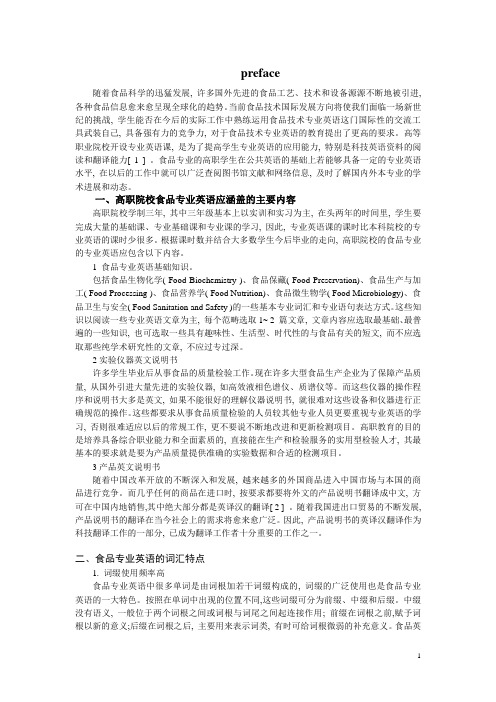
preface随着食品科学的迅猛发展, 许多国外先进的食品工艺、技术和设备源源不断地被引进, 各种食品信息愈来愈呈现全球化的趋势。
当前食品技术国际发展方向将使我们面临一场新世纪的挑战, 学生能否在今后的实际工作中熟练运用食品技术专业英语这门国际性的交流工具武装自己, 具备强有力的竞争力, 对于食品技术专业英语的教育提出了更高的要求。
高等职业院校开设专业英语课, 是为了提高学生专业英语的应用能力, 特别是科技英语资料的阅读和翻译能力[ 1 ] 。
食品专业的高职学生在公共英语的基础上若能够具备一定的专业英语水平, 在以后的工作中就可以广泛查阅图书馆文献和网络信息, 及时了解国内外本专业的学术进展和动态。
一、高职院校食品专业英语应涵盖的主要内容高职院校学制三年, 其中三年级基本上以实训和实习为主, 在头两年的时间里, 学生要完成大量的基础课、专业基础课和专业课的学习, 因此, 专业英语课的课时比本科院校的专业英语的课时少很多。
根据课时数并结合大多数学生今后毕业的走向, 高职院校的食品专业的专业英语应包含以下内容。
1 食品专业英语基础知识。
包括食品生物化学( Food Biochemistry )、食品保藏( Food Preservation)、食品生产与加工( Food Processing )、食品营养学( Food Nutrition)、食品微生物学( Food Microbiology)、食品卫生与安全( Food Sanitation and Safety )的一些基本专业词汇和专业语句表达方式。
这些知识以阅读一些专业英语文章为主, 每个范畴选取1~ 2 篇文章, 文章内容应选取最基础、最普遍的一些知识, 也可选取一些具有趣味性、生活型、时代性的与食品有关的短文, 而不应选取那些纯学术研究性的文章, 不应过专过深。
2实验仪器英文说明书许多学生毕业后从事食品的质量检验工作。
现在许多大型食品生产企业为了保障产品质量, 从国外引进大量先进的实验仪器, 如高效液相色谱仪、质谱仪等。
食品安全专业中英文对照外文翻译文献

中英文翻译(文档含英文原文和中文翻译)附件1:翻译译文热处理对豆奶(豆腥味)过氧化脂质含量的影响豆腥味是导致豆奶风味不理想的重要因素,为了以最大限度的降低豆奶的豆腥味,我们研究了热处理对过氧化脂质的影响,是影响豆腥味的一个重要因素。
我们还以豆奶为原料并在制作过程中使用加热工序制备了各种甜点,从而通过感官实验来评价加热对其的影响。
经过浸泡和在75℃热处理的肿涨的大豆在相对湿度80-90%处理十分钟的过氧化脂质的含量比大豆中缺乏脂氧合酶和14%或更少的热处理的大豆制备出的豆奶的过氧化脂质含量要大大降低。
此外,设计热烫浸泡和肿胀的大豆在沸水中处理了30秒的豆奶的过氧化脂质含量可以与缺失脂肪氧合酶的大豆制作出的豆奶过氧化脂质含量相媲美。
蛋奶布丁,巴伐利亚奶油以及经过热处理的大豆制作出的豆腐其中的豆腥味都得到了显著的改善。
关键词:大豆豆奶过氧化脂质豆腥味大豆长期以来都是作为高营养食品代名词在日本人的饮食文化中具有具足轻重的作用。
最近的研究表明,大豆蛋白具有降低胆固醇的作用(爱德森等人,1995),大豆皂苷具有抗癌活性(肯尼迪,1995),以及大豆异黄酮对乳腺癌和前列腺癌具有一定的抑制作用(彼得森&贝尔内斯,1991;彼得森G&贝尔内斯S,1993),以及对于骨质疏松症(土田等人,1999)具有一定的预防作用。
根据以上情况可知,由大豆制成的加工食品的价值就是作为人体异黄酮的来源。
大豆被用于很多的食品中,包括豆腐,纳豆,味精,酱油,豆浆。
豆奶作为一种可利用的饮料,可以广泛应用于果冻,蛋奶布丁等甜品的制作原料。
然而,脂肪氧合酶产生的独特的豆腥味对消费者的喜好产生了重大的影响。
因此尽可能的减少豆腥味是能够使豆浆脱颖而出并广泛推广的关键性的挑战。
有几种用于激活脂肪氧合酶的方法已经被提出:温水处理研磨的方法(越后等,1991),其中,大豆在70℃热水中浸泡,然后用95℃的热水进行匀浆;热烫(赛斯&纳特,1988)的方法,用99.3℃的热水进行处理,以及微波加热的方法(王&托莱多,1987)。
食品英文文献带翻译
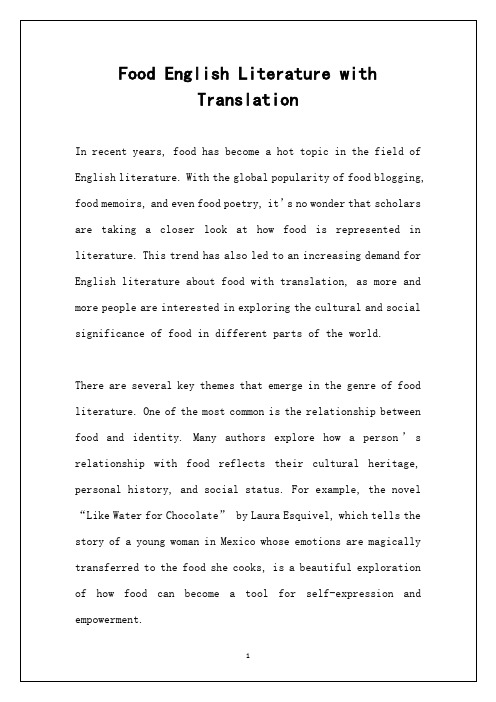
In addition to these themes, food literature also examines the politics of food, the ethics of eating, and the sensory experience of food. For instance, the essay collection “The Gastronomical Me” by M.F.K. Fisher delves into the cultural and social implications of different food rituals and traditions around the world. Fisher’s lyrical prose and insightful observations offer readers a deeper understanding of how food shapes our daily lives and our sense of belonging.
课程思政融入食品专业英语及科技文献检索教学的探索
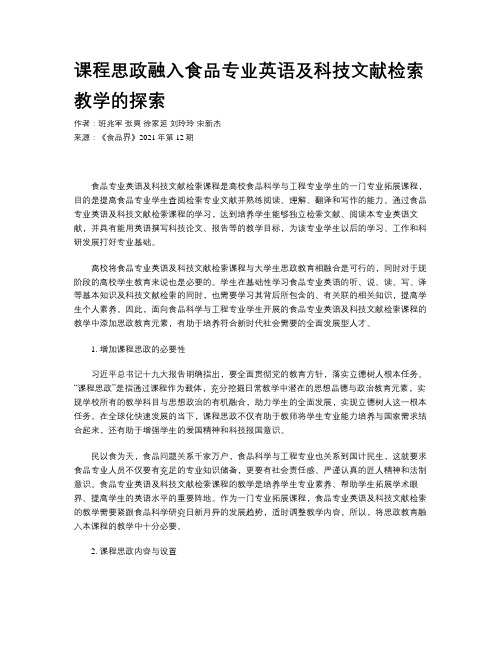
课程思政融入食品专业英语及科技文献检索教学的探索作者:班兆军张爽徐家延刘玲玲宋新杰来源:《食品界》2021年第12期食品专业英语及科技文献检索课程是高校食品科学与工程专业学生的一门专业拓展课程,目的是提高食品专业学生查阅检索专业文献并熟练阅读、理解、翻译和写作的能力。
通过食品专业英语及科技文献检索课程的学习,达到培养学生能够独立检索文献、阅读本专业英语文献,并具有能用英语撰写科技论文、报告等的教学目标,为该专业学生以后的学习、工作和科研发展打好专业基础。
高校将食品专业英语及科技文献检索课程与大学生思政教育相融合是可行的,同时对于现阶段的高校学生教育来说也是必要的。
学生在基础性学习食品专业英语的听、说、读、写、译等基本知识及科技文献检索的同时,也需要学习其背后所包含的、有关联的相关知识,提高学生个人素养。
因此,面向食品科学与工程专业学生开展的食品专业英语及科技文献检索课程的教学中添加思政教育元素,有助于培养符合新时代社会需要的全面发展型人才。
1. 增加课程思政的必要性习近平总书记十九大报告明确指出,要全面贯彻党的教育方针,落实立德树人根本任务。
“课程思政”是指通过课程作为载体,充分挖掘日常教学中潜在的思想品德与政治教育元素,实现学校所有的教学科目与思想政治的有机融合,助力学生的全面发展,实现立德树人这一根本任务。
在全球化快速发展的当下,课程思政不仅有助于教师将学生专业能力培养与国家需求结合起来,还有助于增强学生的爱国精神和科技报国意识。
民以食为天,食品问题关系千家万户,食品科学与工程专业也关系到国计民生,这就要求食品专业人员不仅要有充足的专业知识储备,更要有社会责任感、严谨认真的匠人精神和法制意识。
食品专业英语及科技文献检索课程的教学是培养学生专业素养、帮助学生拓展学术眼界、提高学生的英语水平的重要阵地。
作为一门专业拓展课程,食品专业英语及科技文献检索的教学需要紧跟食品科学研究日新月异的发展趋势,适时调整教学内容,所以,将思政教育融入本课程的教学中十分必要。
食品专业英语教案
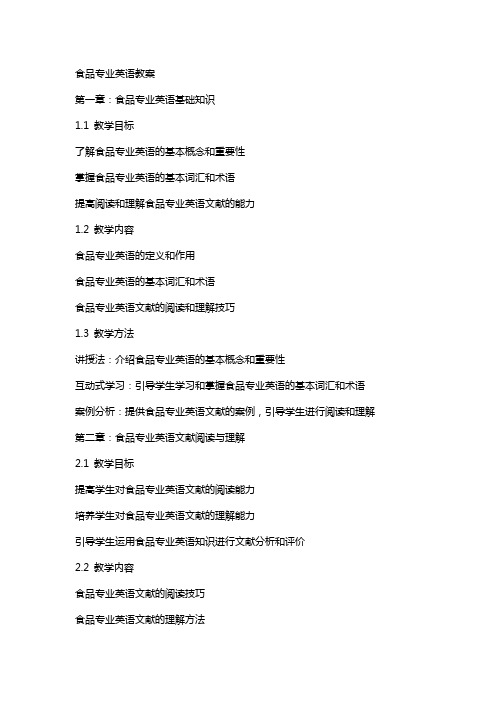
食品专业英语教案第一章:食品专业英语基础知识1.1 教学目标了解食品专业英语的基本概念和重要性掌握食品专业英语的基本词汇和术语提高阅读和理解食品专业英语文献的能力1.2 教学内容食品专业英语的定义和作用食品专业英语的基本词汇和术语食品专业英语文献的阅读和理解技巧1.3 教学方法讲授法:介绍食品专业英语的基本概念和重要性互动式学习:引导学生学习和掌握食品专业英语的基本词汇和术语案例分析:提供食品专业英语文献的案例,引导学生进行阅读和理解第二章:食品专业英语文献阅读与理解2.1 教学目标提高学生对食品专业英语文献的阅读能力培养学生对食品专业英语文献的理解能力引导学生运用食品专业英语知识进行文献分析和评价2.2 教学内容食品专业英语文献的阅读技巧食品专业英语文献的理解方法食品专业英语文献的分析和评价2.3 教学方法讲授法:介绍食品专业英语文献的阅读技巧和理解方法互动式学习:引导学生进行食品专业英语文献的阅读和理解案例分析:提供食品专业英语文献的案例,引导学生进行分析和评价第三章:食品专业英语写作与交流3.1 教学目标提高学生对食品专业英语写作的能力培养学生对食品专业英语交流的技巧引导学生运用食品专业英语知识进行写作和交流3.2 教学内容食品专业英语写作的基本原则和技巧食品专业英语交流的基本方法和策略食品专业英语写作和交流的实践训练3.3 教学方法讲授法:介绍食品专业英语写作的基本原则和技巧互动式学习:引导学生进行食品专业英语写作和交流的实践训练案例分析:提供食品专业英语写作和交流的案例,引导学生进行分析和评价第四章:食品专业英语听说能力培养4.1 教学目标提高学生对食品专业英语听说的能力培养学生对食品专业英语听说的技巧引导学生运用食品专业英语知识进行听说交流4.2 教学内容食品专业英语听说的基本原则和技巧食品专业英语听说的重要性和应用场景食品专业英语听说实践训练4.3 教学方法讲授法:介绍食品专业英语听说的基本原则和技巧互动式学习:引导学生进行食品专业英语听说的实践训练案例分析:提供食品专业英语听说的案例,引导学生进行分析和评价第五章:食品专业英语翻译能力培养5.1 教学目标提高学生对食品专业英语翻译的能力培养学生对食品专业英语翻译的技巧引导学生运用食品专业英语知识进行翻译实践5.2 教学内容食品专业英语翻译的基本原则和技巧食品专业英语翻译的重要性和应用场景食品专业英语翻译实践训练5.3 教学方法讲授法:介绍食品专业英语翻译的基本原则和技巧互动式学习:引导学生进行食品专业英语翻译的实践训练案例分析:提供食品专业英语翻译的案例,引导学生进行分析和评价第六章:食品科学与工程专业英语词汇与术语学习6.1 教学目标掌握食品科学与工程专业常用英语词汇和术语了解词汇和术语在食品科学与工程专业文献中的应用提高阅读和理解食品科学与工程专业英语文献的能力6.2 教学内容食品科学与工程专业常见英语词汇和术语的讲解词汇和术语在食品科学与工程专业文献中的应用案例词汇和术语的记忆和巩固方法6.3 教学方法讲授法:讲解食品科学与工程专业常用英语词汇和术语互动式学习:引导学生学习和掌握词汇和术语案例分析:提供食品科学与工程专业英语文献案例,引导学生应用词汇和术语第七章:食品科学与工程专业英语文献综述写作7.1 教学目标提高学生对食品科学与工程专业英语文献综述的理解和分析能力培养学生运用食品科学与工程专业英语进行学术交流的能力7.2 教学内容食品科学与工程专业英语文献综述的写作案例分析食品科学与工程专业英语文献综述的修改和完善方法7.3 教学方法互动式学习:引导学生进行食品科学与工程专业英语文献综述的写作实践案例分析:提供食品科学与工程专业英语文献综述案例,引导学生进行分析和评价第八章:食品科学与工程专业英语听说能力提升8.1 教学目标提高学生食品科学与工程专业英语听说能力培养学生运用食品科学与工程专业英语进行交流的能力引导学生掌握食品科学与工程专业英语听说技巧8.2 教学内容食品科学与工程专业英语听说技巧讲解食品科学与工程专业英语听说实践训练食品科学与工程专业英语听说考试模拟8.3 教学方法讲授法:讲解食品科学与工程专业英语听说技巧互动式学习:引导学生进行食品科学与工程专业英语听说实践训练案例分析:提供食品科学与工程专业英语听说案例,引导学生进行分析和评价第九章:食品科学与工程专业英语翻译实践9.1 教学目标提高学生食品科学与工程专业英语翻译能力培养学生运用食品科学与工程专业英语进行翻译实践的能力引导学生掌握食品科学与工程专业英语翻译技巧9.2 教学内容食品科学与工程专业英语翻译技巧讲解食品科学与工程专业英语翻译实践训练食品科学与工程专业英语翻译案例分析9.3 教学方法讲授法:讲解食品科学与工程专业英语翻译技巧互动式学习:引导学生进行食品科学与工程专业英语翻译实践训练案例分析:提供食品科学与工程专业英语翻译案例,引导学生进行分析和评价第十章:食品科学与工程专业英语综合应用能力提升10.1 教学目标提高学生食品科学与工程专业英语综合应用能力培养学生运用食品科学与工程专业英语进行学术交流和研究报告的能力引导学生掌握食品科学与工程专业英语综合应用技巧10.2 教学内容食品科学与工程专业英语综合应用技巧讲解食品科学与工程专业英语综合应用实践训练食品科学与工程专业英语综合应用案例分析10.3 教学方法讲授法:讲解食品科学与工程专业英语综合应用技巧互动式学习:引导学生进行食品科学与工程专业英语综合应用实践训练案例分析:提供食品科学与工程专业英语综合应用案例,引导学生进行分析和评价重点解析本教案分为十个章节,涵盖了食品专业英语的基础知识、文献阅读与理解、写作与交流、听说能力提升、翻译实践以及综合应用能力提升等方面。
新时期食品英语特征与翻译技巧思考
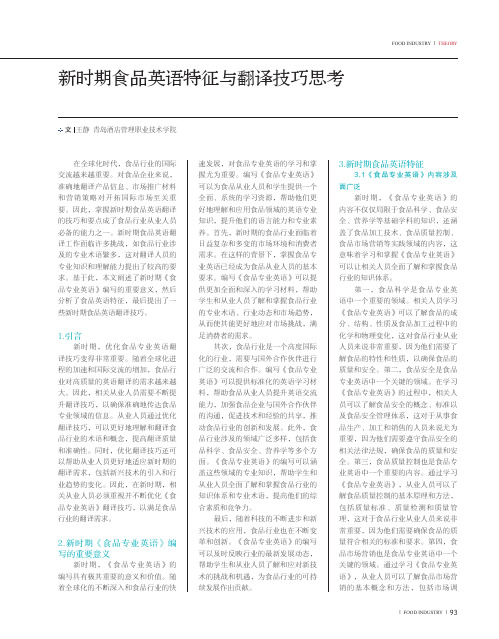
I FOOD INDUSTRY I 93FOOD INDUSTRY I THEORY新时期食品英语特征与翻译技巧思考文 王静青岛酒店管理职业技术学院3.新时期食品英语特征3.1《食品专业英语》内容涉及面广泛新时期,《食品专业英语》的内容不仅仅局限于食品科学、食品安全、营养学等基础学科的知识,还涵盖了食品加工技术、食品质量控制、食品市场营销等实践领域的内容,这意味着学习和掌握《食品专业英语》可以让相关人员全面了解和掌握食品行业的知识体系。
第一,食品科学是食品专业英语中一个重要的领域。
相关人员学习《食品专业英语》可以了解食品的成分、结构、性质及食品加工过程中的化学和物理变化,这对食品行业从业人员来说非常重要,因为他们需要了解食品的特性和性质,以确保食品的质量和安全。
第二,食品安全是食品专业英语中一个关键的领域。
在学习《食品专业英语》的过程中,相关人员可以了解食品安全的概念、标准以及食品安全管理体系,这对于从事食品生产、加工和销售的人员来说尤为重要,因为他们需要遵守食品安全的相关法律法规,确保食品的质量和安全。
第三,食品质量控制也是食品专业英语中一个重要的内容。
通过学习《食品专业英语》,从业人员可以了解食品质量控制的基本原理和方法,包括质量标准、质量检测和质量管理,这对于食品行业从业人员来说非常重要,因为他们需要确保食品的质量符合相关的标准和要求。
第四,食品市场营销也是食品专业英语中一个关键的领域。
通过学习《食品专业英语》,从业人员可以了解食品市场营销的基本概念和方法,包括市场调在全球化时代,食品行业的国际交流越来越重要。
对食品企业来说,准确地翻译产品信息、市场推广材料和营销策略对开拓国际市场至关重要。
因此,掌握新时期食品英语翻译的技巧和要点成了食品行业从业人员必备的能力之一。
新时期食品英语翻译工作面临许多挑战,如食品行业涉及的专业术语繁多,这对翻译人员的专业知识和理解能力提出了较高的要求。
基于此,本文阐述了新时期《食品专业英语》编写的重要意义,然后分析了食品英语特征,最后提出了一些新时期食品英语翻译技巧。
【精品】专业论文文献-“老干妈”:小辣椒的大文章
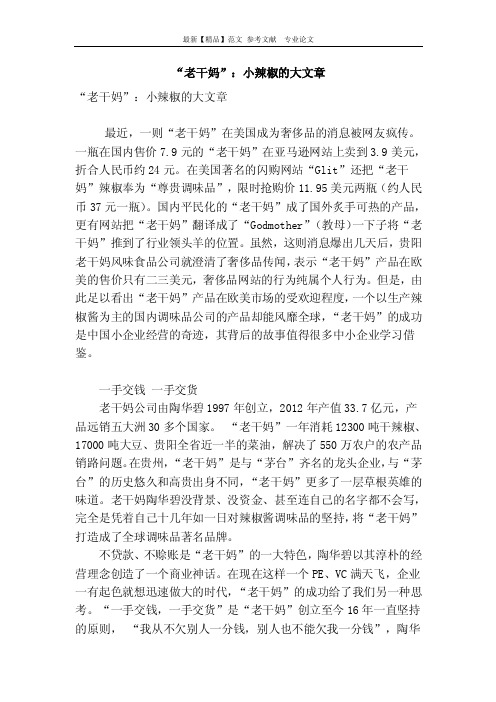
“老干妈”:小辣椒的大文章“老干妈”:小辣椒的大文章最近,一则“老干妈”在美国成为奢侈品的消息被网友疯传。
一瓶在国内售价7.9元的“老干妈”在亚马逊网站上卖到3.9美元,折合人民币约24元。
在美国著名的闪购网站“Glit”还把“老干妈”辣椒奉为“尊贵调味品”,限时抢购价11.95美元两瓶(约人民币37元一瓶)。
国内平民化的“老干妈”成了国外炙手可热的产品,更有网站把“老干妈”翻译成了“Godmother”(教母)一下子将“老干妈”推到了行业领头羊的位置。
虽然,这则消息爆出几天后,贵阳老干妈风味食品公司就澄清了奢侈品传闻,表示“老干妈”产品在欧美的售价只有二三美元,奢侈品网站的行为纯属个人行为。
但是,由此足以看出“老干妈”产品在欧美市场的受欢迎程度,一个以生产辣椒酱为主的国内调味品公司的产品却能风靡全球,“老干妈”的成功是中国小企业经营的奇迹,其背后的故事值得很多中小企业学习借鉴。
一手交钱一手交货老干妈公司由陶华碧1997年创立,2012年产值33.7亿元,产品远销五大洲30多个国家。
“老干妈”一年消耗12300吨干辣椒、17000吨大豆、贵阳全省近一半的菜油,解决了550万农户的农产品销路问题。
在贵州,“老干妈”是与“茅台”齐名的龙头企业,与“茅台”的历史悠久和高贵出身不同,“老干妈”更多了一层草根英雄的味道。
老干妈陶华碧没背景、没资金、甚至连自己的名字都不会写,完全是凭着自己十几年如一日对辣椒酱调味品的坚持,将“老干妈”打造成了全球调味品著名品牌。
不贷款、不赊账是“老干妈”的一大特色,陶华碧以其淳朴的经营理念创造了一个商业神话。
在现在这样一个PE、VC满天飞,企业一有起色就想迅速做大的时代,“老干妈”的成功给了我们另一种思考。
“一手交钱,一手交货”是“老干妈”创立至今16年一直坚持的原则,“我从不欠别人一分钱,别人也不能欠我一分钱”,陶华碧这个简单的坚持,让“老干妈”在快速成长的同时没有受到过资金链的困扰。
食品营养学教学创新成果
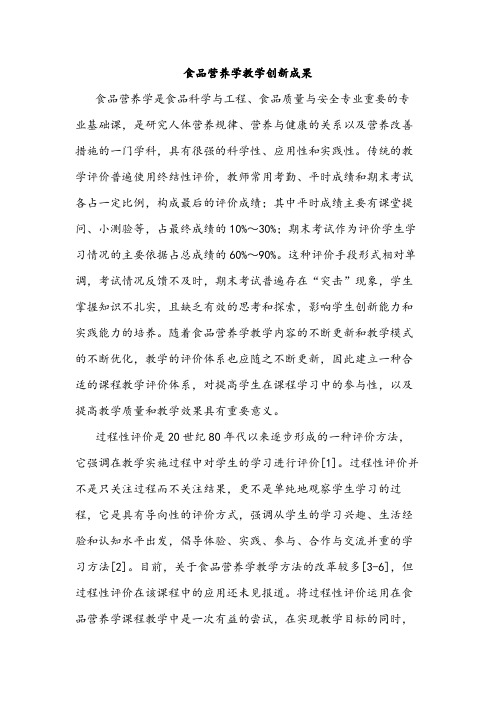
食品营养学教学创新成果食品营养学是食品科学与工程、食品质量与安全专业重要的专业基础课,是研究人体营养规律、营养与健康的关系以及营养改善措施的一门学科,具有很强的科学性、应用性和实践性。
传统的教学评价普遍使用终结性评价,教师常用考勤、平时成绩和期末考试各占一定比例,构成最后的评价成绩;其中平时成绩主要有课堂提问、小测验等,占最终成绩的10%~30%;期末考试作为评价学生学习情况的主要依据占总成绩的60%~90%。
这种评价手段形式相对单调,考试情况反馈不及时,期末考试普遍存在“突击”现象,学生掌握知识不扎实,且缺乏有效的思考和探索,影响学生创新能力和实践能力的培养。
随着食品营养学教学内容的不断更新和教学模式的不断优化,教学的评价体系也应随之不断更新,因此建立一种合适的课程教学评价体系,对提高学生在课程学习中的参与性,以及提高教学质量和教学效果具有重要意义。
过程性评价是20世纪80年代以来逐步形成的一种评价方法,它强调在教学实施过程中对学生的学习进行评价[1]。
过程性评价并不是只关注过程而不关注结果,更不是单纯地观察学生学习的过程,它是具有导向性的评价方式,强调从学生的学习兴趣、生活经验和认知水平出发,倡导体验、实践、参与、合作与交流并重的学习方法[2]。
目前,关于食品营养学教学方法的改革较多[3-6],但过程性评价在该课程中的应用还未见报道。
将过程性评价运用在食品营养学课程教学中是一次有益的尝试,在实现教学目标的同时,提高学生的学习效果和综合素质,同时为过程性评价的广泛应用提供参考和依据。
1食品营养学课程的教学内容和方法1.1课程的主要内容食品营养学主要讨论人体对营养素的需要,食物的营养价值、膳食平衡等。
课程的主要内容包括中国人的营养状况、食物的消化和吸收、能量及各种营养素、各类食物的营养价值、特殊人群营养、营养与疾病和社区营养。
通过该课程的教学,使学生掌握营养学基本原理和基础知识,熟悉不同人群对食品的营养要求及合理膳食的构成,培养学生将来从事营养食品的生产与加工、开发新食品资源、营养保健和配餐的能力;可以指导人们平衡膳食,合理营养,从而达到预防疾病、增进体质、提高健康水平的目的。
- 1、下载文档前请自行甄别文档内容的完整性,平台不提供额外的编辑、内容补充、找答案等附加服务。
- 2、"仅部分预览"的文档,不可在线预览部分如存在完整性等问题,可反馈申请退款(可完整预览的文档不适用该条件!)。
- 3、如文档侵犯您的权益,请联系客服反馈,我们会尽快为您处理(人工客服工作时间:9:00-18:30)。
姜黄素,炎症,衰老和与年龄有关的疾病电子sikora1scapagnini2*,乔凡尼,马里奥barbagallo3摘要一个研讨会的病理生理方面的成功和不成功的老龄化在巴勒莫举行,意大利四月七日至第八2009。
这里讲的西科拉入一些主持人scapagnini和巴加洛总结。
老龄化是所表现出的健康状况下降和增加的概率获得了与年龄有关的疾病如癌症,老年痴呆症,动脉粥样硬化,代谢紊乱和其他。
他们可能造成的低品位炎症氧气驱动力和表现水平的提高前炎症细胞因子如IL - 1,IL - 6和TNF -α,编码的基因激活转录因子-B认为,老龄化是塑料,可以减缓的热量限制以及一些营养。
因此,减缓衰老、延缓发病年龄有关的疾病可能会实现通过阻断核因子-乙依赖炎症。
在这次审查中我们考虑的可能性,香料姜黄素,一强大的抗氧化和抗发炎剂可能能够改善健康状况的老年人。
背景一个研讨会的病理生理方面的成功和成功的老龄化在巴勒莫举行,意大利四月7-8th2009。
评论主题的大肠杆菌。
西科拉,克scapagnini 和米巴加洛总结在这里。
老化和年龄有关的疾病老龄化进程,对长寿,不是基因编程。
有没有基因已选择实际上促进老化。
进化理论假设有一个权衡体维护和繁殖投资[ 1]。
寿命受基因控制的活动代谢,抗氧化系统,修复,细胞衰老和细胞死亡。
其职能逐渐减少由于随机误差的脱氧核糖核酸的复制和大分子的破坏,导致积累衰老细胞和受损组织与年龄。
然而,不同的组织各机关建设不同的显示模式的衰老[2 - 4 ]。
病变积累与年龄主要是,但不完全,增大引起的活性氧物种(氧),最初由哈曼提出的[ 5]。
一个关键的老龄化的有机体是免疫衰老可能发挥作用,在与年龄有关的免疫学变化[ 6]。
长期暴露在过多的抗原(细菌,病毒,外源性,汽车,它可以被视为压力)导致逐渐下降幼稚细胞。
反过来,有一个积累的记忆和效应CD 8+CD 28 -细胞分泌增加了大量的前炎症细胞因子[ 7]。
另一个主要后果慢性暴露抗原是逐步激活巨噬细胞和相关细胞在大多数器官和组织的机构创建之间的不平衡炎症和抗炎剂网络。
这一结果在低年级慢性炎症状态(inflamm-ageing)[ 6]。
inflamm-ageing可以通过增加水平的各种前炎症细胞因子在组织,和其他炎症标志物,如凝血级联组成部分,以及存在的病毒感染引起的以下病毒:病毒和爱泼斯坦巴尔病毒(EB病毒)[ 8]。
蜂窝参加低度炎症状态不仅包括细胞免疫系统也有其他人遗传毒性应激诱导衰老和经历分泌多种炎症细胞因子,以所谓的衰老相关的分泌型(吡啶)[ 9]。
老龄化,虽然不是疾病本身,使机体受到过多的他们。
霍利迪声称,许多与年龄有关的变化是不可区分的与年龄有关的疾病[ 10]。
事实上,它似乎许多与年龄有关的疾病的信号途径与老化的过程。
有人建议,低度炎症可能不是老龄事业本身(inflamm-ageing和柳氮磺胺吡啶),但也有许多与年龄有关的疾病[11 - 13]。
一些线路的证据导致一般接受之间的联系炎症和癌症。
一般来说,癌症和炎症的连接途径:内在的和外在之一。
本内在途径,癌基因激活诱导转化细胞生产的炎症介质,主要通过激活转录转录因子-刚好相反,在外在的途径炎症或传染性条件增加癌症发展的风险。
流行病学研究表明,慢性炎症易于个人不同类型的癌症[ 14]。
最近,炎症已提出的第七个特征癌症[ 15],应增加六规范以前提出的[ 16]。
炎症也被认为是一个关键的初步在动脉粥样硬化的发展[ 13]。
本早期阶段的动脉粥样硬化的特点是吸引/单核细胞粘附到血管内皮和他们迁移到血管壁。
表达的细胞粘附分子促进白细胞粘附到血管内皮和诱导的炎症因子,包括白细胞介素1,α,和C -反应蛋白。
此外,逐步积累巨噬细胞和摄取氧化低密度脂蛋白最终导致产生所谓的泡沫细胞和脂肪条纹开始[ 12]。
似乎-是主要调解人的炎症和内皮功能障碍的老年人[ 17]。
炎症状态已被记录在老年斑块和周围胶质细胞的表达增加对急性期蛋白以及炎症白细胞介素IL - 6和IL - 1等老年痴呆症疾病(广告)患者和动物模型[ 18]。
证据的炎症机制参与广告也是基于这一事实,一定抗炎药物可以修改的过程中疾病[ 19 , 20 ]。
肥胖,胰岛素抵抗和2型糖尿病也密切相关的慢性炎症。
暴露过量的营养物质和能量可以重新启动古代的炎症潜力代谢重要的组织。
脂肪组织中的肥胖者事实上已经显示出较高的水平前炎症细胞因子(肿瘤坏死因子,白细胞介素- 6)等炎症因素[ 21]。
假设一个链接之间的老龄化和老年疾病引起的关键问题是否集中精力治疗年龄相关疾病是最佳方法,使我们的晚年生活更加舒适健康。
事实上,一个新的战略希望能导致健康的老龄化问题已提出了。
最近,它已被假定,干预旨在减缓老龄化可以提供一个多更大的效益比针对个别疾病[ 22]。
进化理论表明,一次性索玛老化是不可避免的,但可塑性塑料[ 23],这也许有可能通过饮食或药物干预或遗传改变,到延长寿命[ 22]。
姜黄素作为抗炎剂营养的食品配料,要么有一个证明生理效益或提供保护对慢性疾病。
他们可能有助于预防疾病和老化。
饮食有重大作用在调节的风险发展的几种疾病和成功的老龄化。
食用植物,其中饮食成分,是重要的,它们包含植物化学物质,可以控制生化过程在细胞水平的动物机体。
其中的营养,姜黄素作用是支持通过一系列的科学证据已经证实了其抗炎和抗氧化行动在体内和体外。
姜黄素是植物来自根茎的姜黄,目前在香料姜黄,这给印度咖喱的黄颜色。
姜黄素已用于千年为伤口愈合剂,用于治疗各种疾病在传统的印度和中国医学。
最近,它已引起研究人员一种能够抑制癌细胞增殖细胞和/或诱导多种信号通路不同模式的细胞死亡[来]。
细胞死亡诱导姜黄素取得了深厚的兴趣作为一种化学抗癌药物发现和确认在许多的体外实验和临床在动物模型的研究。
此外姜黄素起来的利益作为一个代理潜在的使用在治疗许多疾病(不仅是癌症)与炎症成分包括心血管病,阿尔茨海默病,类风湿性关节炎关节炎和代谢综合征。
虽然只有少数全球临床试验,现在正在进行[ 26],一大量的研究中使用的动物和细胞模型已经进行了阐明的分子机制和生物作用的姜黄素。
姜黄素有空前数量的分子目标为其化学,抗氧化抗炎活性(审查最近在[27 , 28]。
简言之,这些目标包括转录因子与AP - 1描述为第一人,和其他人例如,统计- 3,1,2,ppar-g之,印章,中,β- catenin和纳-乙,酶等蛋白激酶(激酶,蛋白激酶C,粘着斑激酶,钢骨混凝土),谷胱甘肽stransferase,脱氧核糖核酸topoisomerase-ii,端粒酶,血红素氧合酶—1,研究组蛋白乙酰转移酶,金属蛋白酶,脂肪氧化酶(液氧),环氧合酶- 2(环氧—2)和其他人。
最深远的生理后果似乎来自行动姜黄素抑制活性的转录因子-B-乙转录因子是一个主调节器炎症过程的激活表达的许多前炎症细胞因子,如α与IL - 6。
一些因子-引起的蛋白质,如α,也是其激活,这是特别重要的慢性炎症状态。
-乙似乎是罪魁祸首inflammageing,自这个信号系统整合调节细胞内免疫反应的老化和年龄疾病[ 29]。
许多活动姜黄素也可以解释为它能够抑制急性和慢性炎症清除活性氧和活性氮物种增强抗氧化防御(即增加谷胱甘肽水平)。
然而,姜黄素不仅是一简单的抗氧化剂,但作为一个亲电化合物触发Nrf 2/信号转导通路中起着关键作用,激活抗氧化酶,阶段2酶和血红素氧合酶-vitagens(称为,热休克蛋白,硫氧还蛋白还原酶和西每),这可能有一个关键的作用,氧化应激引起的疾病[ 30]。
大量的数据证明有益的影响姜黄素防止不同的疾病,特别是那些有关年龄的增加。
它看来,非凡的潜力姜黄素,这使得它几乎普遍的补救,结果从炎症的起源的许多疾病和姜黄素抗炎活性。
尽管实际缺乏数据显示姜黄素影响老龄化和寿命,有一种强烈的合理的论据表明,姜黄素能影响衰老的进程和老化迟钝[ 25]。
姜黄素和广告近年来姜黄素已提议作为一个潜在的药物对脑老化和神经退行性疾病[ 31],它已被评估在临床试验试验中的患者,与令人鼓舞的初步结果[ 32]。
姜黄素是高度亲脂和可能跨血脑屏障(血脑屏障)到达大脑。
虽然其生物利用度很低,因为毒品是迅速代谢的共轭,姜黄素可能达到大脑足够浓度激活信号转导事件和减少抗体聚集[ 33]。
流行病学研究表明,姜黄素,一个最普遍的营养和药用成分使用的印度人口,负责显着降低(4.4倍)流行广告印度相比,美国[ 34]。
此外新加坡老人谁吃了咖喱姜黄较高的简易精神状态检查评分比谁不[ 35]。
结论姜黄素能对抗炎症状态这被认为是参与许多与年龄有关的疾病。
事实上,看来,姜黄素直接影响几个主要的目标,如活性氧清除和生产与纳-乙信号通路,可以在从而抑制炎症状态参与病因老化和年龄有关的疾病。
主要关注的治疗价值姜黄素是其生物利用度差,,,等一方面,保证缺乏毒性即使在消费每日8毫克剂量。
此外,迄今为止的数据收集,表明,姜黄素具有很高的活动不仅在在体外实验中,但也在个体水平。
这可以解释其hormetic活动[ 36]。
因此,看来,姜黄素是一种很安全有益的保健品的香料可能抵御老化与年龄有关的疾病。
然而,在这个时候没有数据显示任何保健品的可能影响老龄化和寿命,和完全随机的临床试验在人类还需要确认的潜在使用的姜黄素在预防疾病炎症成分,如心血管疾病,广告,心脏综合征,和老化。
